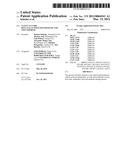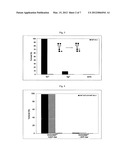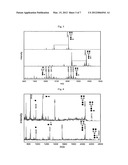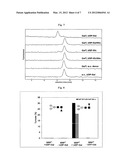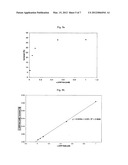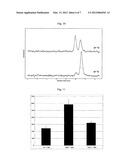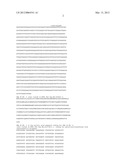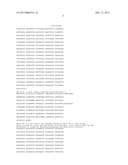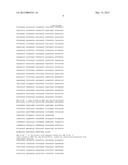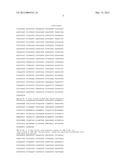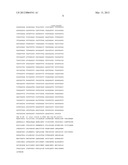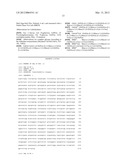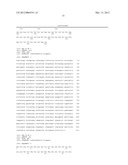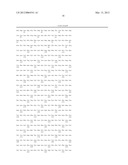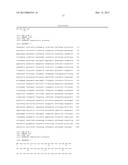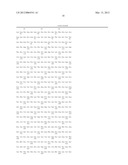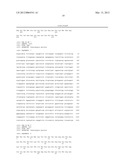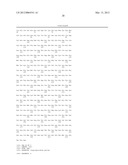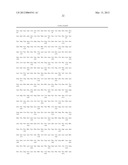Patent application title: N-GLYCAN CORE BETA-GALACTOSYLTRANSFERASE AND USES THEREOF
Inventors:
Markus Künzler (Neuenhof, CH)
Markus Künzler (Neuenhof, CH)
Markus Aebi (Wettingen, CH)
Markus Aebi (Wettingen, CH)
Lain Wilson (Vienna, AT)
Alexander Walter Titz (Kreuzlingen, CH)
Michael Hengartner (Zurich, CH)
Alex Butschi (Hinwil, CH)
Assignees:
ETH ZÜRICH
UNIVERSITÄT FÜR BODENKULTUR WIEN
UNIVERSITÄT ZÜRICH
IPC8 Class: AG01N3353FI
USPC Class:
435 71
Class name: Chemistry: molecular biology and microbiology measuring or testing process involving enzymes or micro-organisms; composition or test strip therefore; processes of forming such composition or test strip involving antigen-antibody binding, specific binding protein assay or specific ligand-receptor binding assay
Publication date: 2012-03-15
Patent application number: 20120064541
Abstract:
The present invention relates to new galactosyltransferases, nucleic
acids encoding them, as well as recombinant vectors, host cells,
antibodies, uses and methods relating thereto.Claims:
1. An isolated and purified nucleic acid, wherein said nucleic acid is
selected from the group consisting of: (i) a nucleic acid comprising at
least a nucleic acid sequence selected from the group consisting of
nucleic acid sequences listed in SEQ ID NOs: 1, 3, 5, 7 and 9; (ii) a
nucleic acid having a sequence of at least 60 or 70% identity, preferably
at least 80 or 90% identity, more preferred at least 95% identity, most
preferred at least 98% identity with the nucleic acid sequence listed in
SEQ ID NO 1; (iii) a nucleic acid that hybridizes to a nucleic acid of
(i) or (ii); (iv) a nucleic acid, wherein said nucleic acid is derivable
by substitution, addition and/or deletion of one of the nucleic acids of
(i), (ii) oder (iii); (v) a fragment of any of the nucleic acids of (i)
to (iv), that hybridizes to a nucleic acid of (i).
2. The nucleic acid according to claim 1, wherein said nucleic acid is a DNA, RNA or PNA, preferably DNA or PNA, more preferably DNA.
3. The nucleic acid according to claim 1, wherein said nucleic acid encodes a protein having galactosyltransferase activity, preferably β-1,4-galactosyltransferase activity, preferably with L-fucoside-, more preferably with α-L-fucoside-, more preferably with Fuc-.alpha.-1,6-GlcNAc-- and most preferably with GnGnF6-- containing poly/oligosaccharides or glycoconjugates as acceptor substrates.
4. An isolated and purified polypeptide selected from the group consisting of: (a) polypeptides having an amino acid sequence selected from the group consisting of SEQ ID NOs: 2, 4, 6, 8 and 10, preferably SEQ ID NO: 2, (b) polypeptides encoded by a nucleic acid of claim 1, (c) polypeptides having an amino acid sequence identity of at least 25, 30 or 40%, preferably at least 50 or 60%, more preferably at least 70 or 80%, most preferably at least 90 or 95% with the polypeptides of (a) and/or (b), (d) a fragment and/or functional derivative of (a), (b) or (c).
5. The polypeptide according to claim 4, wherein said polypeptide has galactosyltransferase activity, preferably β-1,4-galactosyltransferase activity, preferably with L-fucoside-, more preferably with α-L-fucoside-, more preferably with Fuc-.alpha.-1,6-GlcNAc-- and most preferably with GnGnF6-containing poly/oligosaccharides or glycoconjugates as acceptor substrates.
6. A recombinant vector comprising a nucleic acid of claim 1, preferably a viral or episomal vector, preferably a baculovirus vector.
7. A host cell comprising a nucleic acid claim 1, preferably selected from the group consisting of yeast cells, preferably Saccharomyces cerevisiae, Pichia pastoris cells, E. coli cells, plant cells, preferably Nicotiana tabacum or Physcomitrella patens cells, NIH-3T3 mammalian cells and insect cells, more preferably sf9 insect cells.
8. An antibody that specifically binds a polypeptide of claim 4.
9. An antibody according to claim 8, wherein said antibody is monoclonal antibody.
10. Hybridoma cell line, expressing a monoclonal antibody that specifically binds a polypeptide according to claim 5.
11. Use of a polypeptide of claim 4, a cell extract comprising a polypeptide of claim 4, preferably a Caenorhabditis elegans, Caenorhabditis briggsae, Nematostella vectensis, Taeniopygia guttata or Cryptosporidium parvum extract, and/or a host cell comprising a nucleic acid, selected from the group consisting of yeast cells, E. Coli, plant cells, NIH-3T3 mammalian cells and insect cells, for producing galactosyl-containing oligo/polysaccharides and/or glycoconjugates, preferably galactosyl-fucoside-containing oligo/polysaccharides and/or glycoconjugates, more preferably D-galactopyranosyl-.beta.-1,4-L-fucopyranosyl-.alpha.-1,6-GlcNAc-containi- ng oligo/polysaccharides and/or glycoconjugates, most preferably GnGnF6Gal- and/or MMF6Gal-containing oligosaccharides and glycoconjugates.
12. Method for producing galactosyl-fucosyl derivatives, comprising the following steps: (i) providing at least one polypeptide of the invention, (ii) providing at least one fucosylated acceptor substrate, (iii) incubating (i) and (ii) in the presence of at least one suitable divalent metal cation cofactor, preferably selected from manganese (II), cobalt (II) and/or iron (II) ions, more preferably manganese (II), and at least one activated sugar substrate, preferably uridine diphosphate (UDP)-galactose under conditions suitable for enzymatic activity of the polypeptide of the invention, (iv) optionally isolating the galactosyl-fucose derivatives.
13. Use of at least one polypeptide of claim 4, a host cell comprising a nucleic acid, selected from the group consisting of yeast cells, E. Coli, plant cells, NIH-3T3 mammalian cells and insect cells, and/or cell extracts of Caenorhabditis elegans, Caenorhabditis briggsae, Nematostella vectensis, Taeniopygia guttata and/or Cryptosporidium parvum for covalently binding galactosyl compounds to core-fucosylated alpha-fetoprotein (AFP), preferably for detecting and/or quantifying hepatocellular carcinoma (HCC).
14. A method of diagnosis, comprising the following steps: (i) providing blood or a fraction thereof, that comprises AFP, preferably serum, (ii) incubating said blood or said fraction thereof with (a) a polypeptide of claim 4, a host cell comprising a nucleic acid, selected from the group consisting of yeast cells, E. Coli, plant cells, NIH-3T3 mammalian cells and insect cells, and/or cell extracts of Caenorhabditis elegans, Caenorhabditis briggsae, Nematostella vectensis, Taeniopygia guttata and/or Cryptosporidium parvum and (b) an activated galactosyl derivative, preferably a labelled galactosyl derivative, preferably labelled UDP-galactose, under conditions that allow for the galactosyl-transfer of activated galactose to core-fucosylated AFP (AFP-L3), (iii) and detecting the galactose-labelled and hence core-fucosylated AFP (AFP-L3).
15. Use of antibodies according to claim 8 for identifying and/or quantifying nematodes or pathogens, preferably Caenorhabditis elegans, Caenorhabditis briggsae and/or Cryptosporidium parvum in a sample of interest, for example a human or mammalian sample, preferably in a cell fraction or extract sample.
Description:
[0001] The present invention relates to new galactosyltransferases,
nucleic acids encoding them, as well as recombinant vectors, host cells,
antibodies, uses and methods relating thereto.
[0002] The "roundworms" or "nematodes" are the most diverse phylum of pseudocoelomates and one of the most diverse of all animals. Nematode species are difficult to distinguish; over 80,000 have been described, of which over 15,000 are parasitic. It has been estimated that the total number of roundworm species might be more than 500,000. Nematodes are ubiquitous in freshwater, marine and terrestrial environments. The many parasitic forms include pathogens in most plants, animals and also in humans.
[0003] Caenorhabditis elegans is a model nematode and is unsegmented, vermiform, bilaterally symmetrical, with a cuticle integument, four main epidermal cords and a fluid-filled pseudocoelomate cavity. In the wild, it feeds on bacteria that develop on decaying vegetable matter. Hannemann et al. (Glycobiology, 16, 874, 2006) isolated and structurally characterized D-galactopyranosyl-β-1,4-L-fucopyranosyl-α-1,6-D-GlcNAc (Gal-Fuc) epitopes at the core of N-glycans from Caenorhabditis elegans. The N-glycosylation pattern of Caenorhabditis elegans was recently reviewed in Paschinger et al. (Carbohydrate Res., 343, 2041, 2008).
[0004] It is the object of the present invention to provide new means for the recombinant production of Gal-Fuc-containing (poly/oligo)saccharides and Gal-Fuc-containing glycoconjugates. An additional object is to provide new uses for Gal-Fuc-containing poly/oligosaccharides and Gal-Fuc-containing glycoconjugates.
[0005] In a first aspect, the object is solved by an isolated and purified nucleic acid selected from the group consisting of: [0006] (i) a nucleic acid comprising at least a nucleic acid sequence selected from the group consisting of nucleic acid sequences listed in SEQ ID NOs: 1, 3, 5, 7 and 9, preferably SEQ ID NO 1; [0007] (ii) a nucleic acid having a sequence of at least 60, 65, 70 or 75% identity, preferably at least 80, 85 or 90% identity, more preferred at least 95% identity, most preferred at least 98% identity with a nucleic acid sequence selected from the group consisting of nucleic acid sequences listed in SEQ ID NOs 1, 3, 5 and 7, preferably SEQ ID NO: 1; [0008] (iii) a nucleic acid that hybridizes to a nucleic acid of (i) or (ii); [0009] (iv) a nucleic acid, wherein said nucleic acid is derivable by substitution, addition and/or deletion of one of the nucleic acids of (i), (ii) or (iii); [0010] (v) a fragment of any of the nucleic acids of (i) to (iv), that hybridizes to a nucleic acid of (i).
[0011] In a preferred aspect the isolated and purified nucleic acid selected from the group consisting of: [0012] (i) a nucleic acid comprising at least a nucleic acid sequence selected from the group consisting of nucleic acid sequences listed in SEQ ID NOs: 1, 3, 7 and 9 as well as the first 1428 nucleic acids of SEQ ID NO: 5, preferably SEQ ID NO 1; [0013] (ii) a nucleic acid having a sequence of at least 60, 65, 70 or 75% identity, preferably at least 80, 85 or 90% identity, more preferred at least 95% identity, most preferred at least 98% identity with a nucleic acid sequence selected from the group consisting of nucleic acid sequences listed in SEQ ID NOs 1, 3 and 7 as well as the first 1428 nucleic acids of SEQ ID NO: 5, preferably SEQ ID NO: 1; [0014] (iii) a nucleic acid that hybridizes to a nucleic acid of (i) or (ii); [0015] (iv) a nucleic acid, wherein said nucleic acid is derivable by substitution, addition and/or deletion of one of the nucleic acids of (i), (ii) or (iii); [0016] (v) a fragment of any of the nucleic acids of (i) to (iv), that hybridizes to a nucleic acid of (i).
[0017] Preferably, the above nucleic acids encode a polypeptide of the invention, preferably one having an enzymatic galactosyltransferase activity, more preferably one having a β-1,4-galactosyltransferase activity, preferably one with L-fucoside-, more preferably one with α-L-fucoside-, more preferably one with Fuc-α-1,6-GlcNAc-- and most preferably one with GnGnF6-- (nomenclature according to Schachter, Biochem. Cell. Biol. 64(3), 163-181, 1986) containing poly/oligosaccharides or glycoconjugates as acceptor substrates.
[0018] Galactosyltransferase activity, as used herein, is meant to describe an enzymatic transfer of a galactose residue from an activated donor form (i.e. nucleotide-activated galactose, preferably UDP-Gal) to an acceptor. β-1,4-Galactosyltransferase activity, as used herein, is meant to describe the specificity of the galactosyltransferase activity, i.e the transfer of galactose in a beta 1,4-configuration onto an acceptor molecule. β-1,4-Galactosyltransferase activity on L-fucosides as acceptor substrate, as used herein, is meant to describe the specificity of the galactosyltransferase activity in a beta-linked 1,4-transfer onto L-fucosides as the acceptor substrate. L-fucosides, as meant herein, are meant to describe poly/oligosaccharides or glycoconjugates as acceptor substrates containing terminal L-fucose in alpha, most preferably in alpha-1,6 configuration, e.g. as part of MMF6 or GnGnF6 (Schachter, Biochem. Cell. Biol. 64(3), 163-181, 1986).
[0019] In a most preferred embodiment, the encoded polypeptide comprises a polypeptide sequence selected from the group consisting of polypeptide sequences listed in SEQ ID NOs 2, 4, 6, 8 and 10, preferably SEQ ID NO: 2, or a functional fragment or functional derivative of any of these.
TABLE-US-00001 SEQ ID NO: 1 is the nucleic acid sequence coding for SEQ ID NO 2: (also listed in NCBI as Ref Seq NM_072144.4 and in Wormbase as M03F8.4; coding for galactosyltransferase [referred to as GalT in the Examples section] from Caenorhabditis elegans) ATGCCTCGAATCACCGCCAGTAAAATAGTTCTTCTAATTGCATTATCATTTTGTATTA CTGTTATTTATCACTTTCCAATAGCAACGAGAAGCAGTAAGGAGTACGATGAATATG GAAATGAATATGAAAACGTTGCATCGATAGAGTCGGATATAAAAAATGTACGTCGAT TACTTGACGAGGTACCGGATCCCTCACAAAACCGTCTACAATTCCTGAAACTTGATG AGCATGCTTTTGCATTCTCGGCCTACACAGACGATCGAAATGGAAATATGGGGTAC AAATATGTCCGAGTCCTGATGTTTATCACGTCACAAGACAACTTTTCCTGTGAAATAA ACGGGAGAAAGTCCACAGATGTATCACTTTACGAGTTCTCGGAAAATCACAAAATGA AGTGGCAAATGTTTATTTTGAATTGTAAACTACCCGATGGTATAGATTTCAATAATGT TAGCTCTGTAAAGGTCATAAGAAGCACAACCAAGCAGTTTGTTGATGTGCCGATTCG GTATAGAATTCAAGATGAGAAAATAATTACGCCAGACGAATATGACTATAAAATGTCA ATTTGTGTTCCAGCATTGTTIGGAAATGGATATGATGCAAAGCGAATTGTTGAGITTA TTGAGCTGAATACTTTGCAAGGAATCGAGAAAATATACATTTACACTAATCAAAAAGA GCTTGATGGATCCATGAAGAAAACGTTGAAATACTATTCGGATAATCACAAAATAAC ATTAATTGATTACACATTACCATTCAGAGAGGATGGTGTTTGGTATCACGGGCAATT GGCAACTGTTACTGATTGTTTACTGAGAAACACTGGAATCACAAAATACACATTTTTC AATGATTTTGATGAGTTCTTCGTCCCCGTTATCAAAAGTCGGACTCTCTTTGAAACAA TCAGTGGGCTTTTTGAAGATCCCACTATTGGATCGCAACGAACAGCTTTGAAGTATA TAAATGCAAAAATCAAGAGCGCTCCGTATTCACTGAAAAATATTGTTTCCGAAAAAC GAATTGAAACAAGATTCACGAAATGTGTAGTTCGACCGGAAATGGTTTTTGAACAGG GTATTCATCATACGAGTAGAGTGATTCAAGACAACTATAAAACGGTTTCCCATGGCG GATCCCTTCTACGGGTTTATCATTACAAGGATAAAAAGTATTGTTGCGAAGACGAGA GCCTCTTGAAAAAACGGCATGGAGATCAACTTCGGGAAAAATTCGATTCAGTTGTTG GTCTTTTAGACTTGTAG SEQ ID NO: 2 (also listed in NCBI Ref Seq NP_504545.2) MPRITASKIVLLIALSFCITVIYHFPIATRSSKEYDEYGNEYENVASIESDIKNVRRLLD EVPDPSQNRLQFLKLDEHAFAFSAYTDDRNGNMGYKYVRVLMFITSQDNFSCEINGRK STDVSLYEFSENHKMKWQMFILNCKLPDGIDFNNVSSVKVIRSTTKQFVDVPIRYRIQDE KIITPDEYDYKMSICVPALFGNGYDAKRIVEFIELNTLQGIEKIYIYTNQKELDGSMKKTLK YYSDNHKITLIDYTLPFREDGVWYHGQLATVTDCLLRNTGITKYTFFNDFDEFFVPVIKSR TLFETISGLFEDPTIGSQRTALKYINAKIKSAPYSLKNIVSEKRIETRFTKCVVRPEMVFEQ GIHHTSRVIQDNYKTVSHGGSLLRVYHYKDKKYCCEDESLLKKRHGDQLREKFDSVVG LLDL SEQ ID NO: 3 is the nucleic acid sequence coding for SEQ ID NO: 4: (also listed in NCBI Ref Seq XM_001674213.1; coding for galactosyltransferase from Caenorhabditis briggsae) ATGCCACGAA TAACGGCAAG CAAAATAGTG TTATTATCTG TATTATCCTT ACTAACAGTT TTCTATCTGA ATACATTTTC GTCTATTAAA ATTGAAAACG ATCTCGACGG GACTGATTAC GACTTGGATT ACATAGAATC TGATATCAAA AAGACGCGTC GATTACTCAA TGAAATCCCT GATCCATCTC AAAACCGAGT TCAATTTTTT AAACTCGATG ATAATGGATA TGCATTCTCA GCATATACAG ATAATAGGAA AGGAAATATG GGTCACAAAT ATGTCAGAAT ATTAGTGTTC CTAACTAAAT TTGATGATTT TTCTTGCGAA ATTAACTCGA AGAAATCCTA TGTTGTTACA CTCTACGAGC TATCAGAAAA TCACAATATG AAGTGGAAAA TGTATATTTT GAATTGTTTA CTTCCCGATG GAATCACTTT CAACGATGTG AATTCTGTAA AAATATCTAG AAGTTCTTCA AAACTTTCAG TCCAAATCCC GATCAGATAT AGAATTCAAG ATGAGAAAAT GATGACTCCA GATGAATACG ATTATAAGTT GTCGATTTGT GTTCCTGCAC TTTTTGGAAA CGTTTATTAT CCAAGGAGGA TTATTGAATT TGTGGAACTA AACAGCTTGC AAGACATCGA CAAAATCTAC ATCTACTACA ATCCTTTAGA AATGACAGAT GAGGCCACAG AAAGGACTTT GAAGTTTTAT TCCAATAATG GGAAAATCAA TTTAATAGAA TTCATTCTCC CATTTTCTAC TCGAGATGTT TGGTATTATG GGCAATTGGC CACCGTTACA GATTGTCTTC TCCGTAACAC TGGAATAACT CAATACACAT TTTTCAATGA TTTGGATGAA TTTTTCGTGC CAGTACTGGA CAACCAAACT CTCTCTGAAA CTGTGTCAGG ATTATTTGAA AATCGAAAAA TTGCCTCTCA GAGAACGGCC TTGAAATTTA TTAGTACAAA AATCAATCGA TCTCCTGTAA CTCTCAATAA TATTGTGTCT TCTAAAAATT TTGAAACGAG ATTCACAAAA TGCGTCGTAC GGCCGGAAAT GGTTTTTGAG CAGGGCATTC ACCATACGAG TAGAGTAATA CAAGACGACT ACGAAACCCC ATCCCATGAT GGATCACTTT TGCGTGTGTA TCACTACAGA GAACCAAGAT ATTGCTGCGA AAACGAGAAT CTTCTAAAAC AAAGATACGA TAAGAAGCTT CAAGAAGTTT TTGATGCTGT AGTTCTTATA TTGCATGTCA CATTTGATGT ATGGATATAT CACCTGAAAA ACACCCTCTA A SEQ ID NO: 4 (also listed in NCBI Ref Seq XP_001674265.1) MPRITASKIV LLSVLSLLTV FYLNTFSSIK IENDLDGTDY DLDYIESDIK KTRRLLNEIP DPSQNRVQFF KLDDNGYAFS AYTDNRKGNM GHKYVRILVF LTKFDDFSCE INSKKSYVVT LYELSENHNM KWKMYILNCL LPDGITFNDV NSVKISRSSS KLSVQIPIRY RIQDEKMMTP DEYDYKLSIC VPALFGNVYY PRRIIEFVEL NSLQDIDKIY IYYNPLEMTD EATERTLKFY SNNGKINLIE FILPFSTRDV WYYGQLATVT DCLLRNTGIT QYTFFNDLDE FFVPVLDNQT LSETVSGLFE NRKIASQRTA LKFISTKINR SPVTLNNIVS SKNFETRFTK CVVRPEMVFE QGIHHTSRVI QDDYETPSHD GSLLRVYHYR EPRYCCENEN LLKQRYDKKL QEVFDAVVLI LHVTFDVWIY HLKNTL SEQ ID NO: 5 is the nucleic acid sequence coding for SEQ ID NO: 6 (1428 nucleic acids) followed by a stop codon and further 68 nucleotides: (also listed in NCBI Ref Seq XM_001629141.1; coding for galactosyltransferase from Nematostella vectensis) ATGCGATGCT ATATTTACAA ATTGAGGTTG TCCGTTTGTC TGTTTGTAGT GCTCTTCACA GCACTGCTTT TCATCACCTA TTTAAACCAC TCAGAGCTTG AATCAGCAGA GAAAAGTAGC GGAAAAAGGA AGACGCGACA TCGTAAACGA ACACGTTCAC GCAAACAACA CGAGAGCCAT TTTCAGAAAG CTCGACTACA AGAAAGAGAA CTAGTATTAA GATCTACAGC GCCACCAACA TTACGAAGAG AAGTACAAGC GCATCGATTA GGGCAGATCC GTGGCAAGAA CACGGACCAG GGGATAACTG GAAAGTTCAC AGAGATCGCT AAAGACACGC ATATTTATTC AGCGTTTTAC GACGATGCCA AGTCAAATCC ATTCATTCGT CTTATCATCC TCTCGGGAAA ACACTACCAG CCTGGATTAT CTTGCCAATT TTGCGAACCT TTGTCCGCCA GTTGTAGTTT TGCGGACTCT AAAGCTGAAT ACTACACGAC CAACGAGAAC CATGGGAGAG TATTTGGCGG GTTCATTGCG AGTTGCCTCG TGCCTGATGG ATTCAATGCA GTGCCATTGT TTGTTGACAT AACGGCCGAT GTTAAGGGGG AGAAAAGCAA GGCACGGGTA CCTGTGGTGT CTAATGCACA TCTCTACTAC CCTATTAAAT ACGCAATCTG CGTCCCACCC CTCCGATCAG AGAAACTAAC AGCGAAAAGA CTCATAGAGT TTGTCGAGCT AACCAAACTT TTAGGCGCTA ACCATTTTAC TTTTTATGAC TTCAAAACGG ACCCGGAAGT CAATAACGTT TTAAGATATT ACCAGGAGAC ACAAGTAGCA AATGTTCTGC CATGGAATCT ACCTTCAAAT TTGGTATCCA GGCCGAACGA TATTTGGTAC TTTGGTCAGG TTTTGGCTAT TCTAGATTGC TTGTATCGCT ACAAGAACAG GGCAAAATTT GTAGCCTTCA ATGACGTAGA TGAGTTTATC GTTCCGCTAA GGAACAGCTC GATAGTGGAA ATACTAAACG CGTTTCACCG GCCATACCAC TGTGGACATT GCTTTCAGAG CGTGGTGTTC AGCTCAAACG CGAGATTTCC CAGGCAAAAA AGCGAGTTAG TTTCTCAGCG GTTCTTCCAC AGGACCCAGG AAACCATCCC TCTCCTCTCG AAATGCATTG TGGATCCTTT GAGAGTGTTC GAGATGGGGA TTCACCACAT AAGCAAGGCT ACAGGTCTGC GGTATTCCGT CAACTCAGTA CACGAGAGTG ACGCGGTTAT CTTCCATTAC AGGACTTGCA CTACGTCATT TGGTATACGT CATCAGTGCA TGAACCTAGT GCATGATGGG ACCATGGCCA AATATGGAAA ACGACTTCAG AAAATGTTTA GAAAGGTTGT AAATGATTTA AAACTTTTGG CACCAACGTA GCTATTTCGT AACACTTCAC ACTTTCATTG TTATAACAGA ATACAGAATA AATTAATGAT TGTTGTGCC SEQ ID NO: 6 (also listed in NCBI Ref Seq XP_001629191) MRCYIYKLRL SVCLFVVLFT ALLFITYLNH SELESAEKSS GKRKTRHRKR TRSRKQHESH FQKARLQERE LVLRSTAPPT LRREVQAHRL GQIRGKNTDQ GITGKFTEIA KDTHIYSAFY DDAKSNPFIR LIILSGKHYQ PGLSCQFCEP LSASCSFADS KAEYYTTNEN HGRVFGGFIA SCLVPDGFNA VPLFVDITAD VKGEKSKARV PVVSNAHLYY PIKYAICVPP LRSEKLTAKR LIEFVELTKL LGANHFTFYD FKTDPEVNNV LRYYQETQVA NVLPWNLPSN LVSRPNDIWY FGQVLAILDC LYRYKNRAKF VAFNDVDEFI VPLRNSSIVE ILNAFHRPYH CGHCFQSVVF SSNARFPRQK SELVSQRFFH RTQETIPLLS KCIVDPLRVF EMGIHHISKA TGLRYSVNSV HESDAVIFHY RTCTTSFGIR HQCMNLVHDG TMAKYGKRLQ KMFRKVVNDL KLLAPT SEQ ID NO: 7 is the nucleic acid sequence coding for SEQ ID NO: 8: (also listed in NCBI Ref Seq XM_002189335, coding for galactosyltransferase from Taeniopygia guttata) ATGACTGTAA CTTTAATGCT TGTGGTTTCT TATCTGAGAT TACAGAGACT TTCTCATCAG CCAAAAGTAA TTCAAGAAAG TAGAAGATGT AGAGGGAAAA TTGCCCTTAG CACAATAACA GCATTGGAAG GTAACAAAAC TGATATTATA TCCCCATACT TTGATGACAG AGAAAACAAA ATCACTCGTC TGATTGGGAT TGTTCACCAT AAAGATGTAA AACAACTGTT CTGCTGGTTC TGCTGTCAAG CCAATGGAAA GATATATGTA TCAAAAGCAG AAATAGATGT TCACTCGGAT AGATTTGGAT TCCCTTATGG TGCAGCAGAT ATAATTTGTT TGGAACCTGA
AAACTGTGAT CCAACACATG TATCAATTCA TCAGTCTCCA TATGGAAATA TTGACCAGCT GCCGAGGTTT GAAATTAAAA ATCGCAGGCC TGAGACCTTT TCTGTTGACT TCACCGTGTG CATTTCTGCC ATGTTTGGAA ACTACAACAA TGTCTTGCAG TTTGTACAGA GTATGGAAAT GTATAAGATT CTTGGAGTAC AGAAAGTGGT GATCTATAAG AACAACTGCA GCCATCTGAT GGAGAAAGTC TTGAAATTTT ATATAGAAGA AGGAACTGTT GAGGTAATTC CCTGGCCAAT AGACTCACAC CTCAGGGTTT CTTCTAAATG GCGCTTCATG GAAGACGGGA CACACATTGG CTACTATGGA CAAATCACAG CTCTAAATGA CTGTATATAC CGCAACATGG AAAGGACCAA GTTTGTGGTC CTTAATGACG CTGATGAAAT AATTCTTCCC CTTAAACACC CAGACTGGAA AACAATGATG AACAGTCTTC AGGAGCAAAA CCCAGGGACT AGTGTTTTCC TTTTfGAGAA CCATATCTTC CCAGAAACTG TATTTTCTCC CATGTTCAAC ATTTCATCTT GGAATACTGT GCCAGGTGTT AACATATTGC AGCATGTGTA CAGAGAGCCT GACAGGAAAC ATGTAATCAA TCCCAGGAAA ATGATAGTTG ATCCACGAAA GGTGATTCAG ACTTCAGTCC ATTCTGTCCT ACGTGCTTAT GGGAAGAGCG TGAATGTTCC CATGGAAGTT GCCCTCATTT ATCACTGTCG GAAGGCCCTT CAAGGAAACC TTCCCAGAGA ATCTCTCATC AGGGATACAA CACTGTGGAG ATATAACTCA TCATTAATCA TGAATGTTAA CAAGGTTCTA TCTCAAACCA TGCTGCAAAC TCAAAATTGA SEQ ID NO: 8 (also listed in NCBI Ref Seq XP_002189371) MTVTLMLVVS YLRLQRLSHQ PKVIQESRRC RGKIALSTIT ALEGNKTDII SPYFDDRENK ITRLIGIVHH KDVKQLFCWF CCQANGKIYV SKAEIDVHSD RFGFPYGAAD IICLEPENCD PTHVSIHQSP YGNIDQLPRF EIKNRRPETF SVDFTVCISA MFGNYNNVLQ FVQSMEMYKI LGVQKVVIYK NNCSHLMEKV LKFYIEEGTV EVIPWPIDSH LRVSSKWRFM EDGTHIGYYG QITALNDCIY RNMERTKFVV LNDADEIILP LKHPDWKTMM NSLQEQNPGT SVFLFENHIF PETVFSPMFN ISSWNTVPGV NILQHVYREP DRKHVINPRK MIVDPRKVIQ TSVHSVLRAY GKSVNVPMEV ALIYHCRKAL QGNLPRESLI RDTTLWRYNS SLIMNVNKVL SQTMLQTQN SEQ ID NO: 9 is the nucleic acid sequence coding for SEQ ID NO: 10: (also listed in NCBI Ref Seq XM_626032, coding for galactosyltransferase from Cryptosporidium parvum) ATGCAAAGTA AAGTCATTTT TAGGATCTTG GTATTGATCA TTTCGGTGAT TGGATCCTTA TACTCAATAA TTCAATTAAT GCTAAAGGAG CTATCAAGTA ACAAAAATAT TCAAGAGGTT AGTCATTCAA GGAGGCTAAT AAGTGAACCT TACAGTGAAA GTATTAATGA ACAAAATGAT CAAGATTGGA AAGAACTAAA GCTAATAATT CCAAATCATT CTCAAATTAA CCAGCAGGAA AAAAATGGTA ATTTGATTGA GTTTAAAGTT TATATATACT CAGCATATTA TGATTGGAGA ATAGATAGGA TACGAATAAA TTCACTTATC CCATCGAATT TTTATGATCG AATAGAAATG GAATGTGCAA TAATCTTGGA CAAAAATATT TACACAGGAA CTATTAAAAA AGTGATTCAT AAGGAGCACC ATAATAAAGA ATATGTATCA TCGACTTTAC TCTGCGAAAT TGCAAAAAAT GAAATTAAAT TTGAGGATAT TTCAAGGAAA GTTTTGATAA CAATTTTGGA AAATGGAAAC AGCACAAATA AATCAGAAAT ATGGATAACT CTAAAAAAAA TTCCAAAAAA TAGCTCTAAT AATCATGAGC TGACTGTTTG TGTGAGACCT TGGTGGGGAG AGCCAATAAA GAATGGAAAC TTGGGAAATA AACAAAAATT TAACAATTCA GGGTTAATGC TTGAATTTAT TAATTCATAT TTATTCTTAG GAGCAAATAA ATTTTATTTA TATCAAAATT ACTTGGACAT TGACGAAGAT GTAAGAAATA TAATAAATTA TTATTCTAAT ATCAAAAATG TTTTGGAAAT TATTCCATAC TCATTACCAA TAATTCCATT TAAACAAGTT TGGGATTTCG CACAAACAAC AATGATACAG GACTGCCTAC TAAGAAATAT TGGAAAAACA AAATACTTGT TATTCGTAGA TACCGATGAA TTTGTATTTC CAAACTTGAA AAATTATAAC TTAATGGATT TTTTAAATTT ATTAGAAGCC AACAATCCTT ATTATAAAAA CAAAGTCGGG GCAATGTGGA TTCCAATGTA TTTTCATTTT TTAGAGTGGG AATCTGATAA AAATAATTTG AAGAAATATT CAACAATTGA GAAAAAAATT AAGAAAAAGA TGGCAAATAT TGAGTTTGTT CTATATCGTA AAACATGTAG AATGTTAAGT TCTGGAACAA AAAAAAGTGA CAAGACGAGA AGAAAAGTTA TTATTAGACC TGAAAGAGTT TTGTATATGG GTATACATGA AACAGAAGAG ATGCTAAGCA AAAAATTTCA TTTCATTAGA GCTCCTGTAA TTAATGTGGG TGGAGGAAAC GAACTAAGTA TATATTTACA TCATTATAGA AAAGCAAAAG GTATTGTAAA CAATGATCCC AAACAAAGAG AACTTGTGAA TATGTATTTA GAAAATGTTT GTTCAGATAA GCTGTTAGAT TCAGGGGGAG ATTCCATTCA AGATGGAGTA ATTGTCGACA ATACTGTTTG GGAGATATTT GGAACACACT TATACCAGAT AATTTTTGAG CATATTAAAG AAATCCAAGA TATGTACACA AATAAGGAAA TAATTAATGG AAATAAAAAT TTAAGTGTTG AAGAATTACA TAATTAA SEQ ID NO: 10 (also listed in NCBI Ref Seq XP_626032) MQSKVIFRIL VLIISVIGSL YSIIQLMLKE LSSNKNIQEV SHSRRLISEP YSESINEQND QDWKELKLII PNHSQINQQE KNGNLIEFKV YIYSAYYDWR IDRIRINSLI PSNFYDRIEM ECAIILDKNI YTGTIKKVIH KEHHNKEYVS STLLCEIAKN EIKFEDISRK VLITILENGN STNKSEIWIT LKKIPKNSSN NHELTVCVRP WWGEPIKNGN LGNKQKFNNS GLMLEFINSY LFLGANKFYL YQNYLDIDED VRNIINYYSN IKNVLEIIPY SLPIIPFKQV WDFAQTTMIQ DCLLRNIGKT KYLLFVDTDE FVFPNLKNYN LMDFLNLLEA NNPYYKNKVG AMWIPMYFHF LEWESDKNNL KKYSTIEKKI KKKMANIEFV LYRKTCRMLS SGTKKSDKTR RKVIIRPERV LYMGIHETEE MLSKKFHFIR APVINVGGGN ELSIYLHHYR KAKGIVNNDP KQRELVNMYL ENVCSDKLLD SGGDSIQDGV IVDNTVWEIF GTHLYQIIFE HIKEIQDMYT NKEIINGNKN LSVEELHN
[0020] The term "nucleic acid encoding a polypeptide" as it is used in the context of the present invention is meant to include allelic variations and redundancies in the genetic code.
[0021] The term "% (percent) identity" as known to the skilled artisan and used herein indicates the degree of relatedness among two or more nucleic acid molecules that is determined by agreement among the sequences. The percentage of "identity" is the result of the percentage of identical regions in two or more sequences while taking into consideration the gaps and other sequence peculiarities.
[0022] The identity of related nucleic acid molecules can be determined with the assistance of known methods. In general, special computer programs are employed that use algorithms adapted to accommodate the specific needs of this task. Preferred methods for determining identity begin with the generation of the largest degree of identity among the sequences to be compared. Preferred computer programs for determining the identity among two nucleic acid sequences comprise, but are not limited to, BLASTN (Altschul et al., J. Mol. Biol., 215, 403-410, 1990) and LALIGN (Huang and Miller, Adv. Appl. Math., 12, 337-357, 1991). The BLAST programs can be obtained from the National Center for Biotechnology Information (NCBI) and from other sources (BLAST handbook, Altschul et al., NCB NLM NIH Bethesda, Md. 20894).
[0023] The nucleic acid molecules according to the invention may be prepared synthetically by methods well-known to the skilled person, but also may be isolated from suitable DNA libraries and other publicly available sources of nucleic acids and subsequently may optionally be mutated. The preparation of such libraries or mutations is well-known to the person skilled in the art.
[0024] In a preferred embodiment, the nucleic acid molecules of the invention are cDNA, genomic DNA, synthetic DNA, RNA or PNA, either double-stranded or single-stranded (i.e. either a sense or an anti-sense strand). The nucleic acid molecules and fragments thereof, which are encompassed within the scope of the invention, may be produced by, for example, polymerase chain reaction (PCR) or generated synthetically using DNA synthesis or by reverse transcription using mRNA from Caenorhabditis elegans, Caenorhabditis briggsae, Nematostella vectensis, Taeniopygia guttata or Cryptosporidium parvum.
[0025] In some instances the present invention also provides novel nucleic acids encoding the polypeptides of the present invention characterized in that they have the ability to hybridize to a specifically referenced nucleic acid sequence, preferably under stringent conditions. Next to common and/or standard protocols in the prior art for determining the ability to hybridize to a specifically referenced nucleic acid sequence under stringent conditions (e.g. Sambrook and Russell, Molecular cloning: A laboratory manual (3 volumes), 2001), it is preferred to analyze and determine the ability to hybridize to a specifically referenced nucleic acid sequence under stringent conditions by comparing the nucleotide sequences, which may be found in gene databases (e.g. http://www.-ncbi.nlm.nih.gov/entrez/query.fcgi?db=nucleotide) with alignment tools, such as e.g. the above-mentioned BLASTN (Altschul et al., J. Mol. Biol., 215, 403-410, 1990) and LALIGN alignment tools.
[0026] Most preferably the ability of a nucleic acid of the present invention to hybridize to a nucleic acid, e.g. those listed in any of SEQ ID NOs 1, 3, 5, 7 and/or 9, is confirmed in a Southern blot assay under the following conditions: 6× sodium chloride/sodium citrate (SSC) at 45° C. followed by a wash in 0.2×SSC, 0.1% SDS at 65° C.
[0027] The nucleic acid of the present invention is preferably operably linked to a promoter that governs expression in suitable vectors and/or host cells producing the polypeptides of the present invention in vitro or in vivo.
[0028] Suitable promoters for operable linkage to the isolated and purified nucleic acid are known in the art. In a preferred embodiment the nucleic acid of the present invention is one that is operably linked to a promoter selected from the group consisting of the Pichia pastoris AOX1 or GAP promoter (see for example Pichia Expression Kit Instruction Manual, Invitrogen Corporation, Carlsbad, Calif.), the Saccharomyces cerevisiae GAL1, ADH1, ADH2, MET25, GPD or TEF promoter (see for example Methods in Enzymology, 350, 248, 2002), the Baculovirus polyhedrin p10 or ie1 promoter (see for example Bac-to-Bac Expression Kit Handbook, Invitrogen Corporation, Carlsbad, Calif., and Novagen Insect Cell Expression Manual, Merck Chemicals Ltd., Nottingham, UK), the E. coli T7, araBAD, rhaP BAD, tetA, lac, trc, tac or pL promoter (see Applied Microbiology and Biotechnology, 72, 211, 2006), the plant CaMV35S, ocs, nos, Adh-1, Tet promoters (see e.g. Lau and Sun, Biotechnol Adv. 27, 1015-1022, 2009) or inducible promoters for mammalian cells as described in Sambrook and Russell (2001).
[0029] Preferably, the isolated and purified nucleic acid is in the form of a recombinant vector, such as an episomal or viral vector. The selection of a suitable vector and expression control sequences as well as vector construction are within the ordinary skill in the art. Preferably, the viral vector is a baculovirus vector (see for example Bac-to-Bac Expresssion Kit Handbook, Invitrogen Corporation, Carlsbad, Calif.). Vector construction, including the operable linkage of a coding sequence with a promoter and other expression control sequences, is within the ordinary skill in the art.
[0030] Hence and in a further aspect, the present invention relates to a recombinant vector, comprising a nucleic acid of the invention.
[0031] A further aspect of the present invention is directed to a host cell comprising a nucleic acid and/or a vector of the invention and preferably producing polypeptides of the invention. Preferred host cells for producing the polypeptide of the invention are selected from the group consisting of yeast cells, preferably Saccharomyces cerevisiae (see for example Methods in Enzmology, 350, 248, 2002), Pichia pastoris cells (see for example Pichia Expression Kit Instruction Manual, Invitrogen Corporation, Carlsbad, Calif.), E. coli cells (BL21(DE3), K-12 and derivatives) (see for example Applied Microbiology and Biotechnology, 72, 211, 2006), plant cells, preferably Nicotiana tabacum or Physcomitrella patens (see e.g. Lau and Sun, Biotechnol Adv. 27, 1015-1022, 2009), NIH-3T3 mammalian cells (see for example Sambrook and Russell, 2001) and insect cells, preferably sf9 insect cells (see for example Bac-to-Bac Expression Kit Handbook, Invitrogen Corporation, Carlsbad, Calif.)
[0032] Another important aspect of the invention is directed to an isolated and purified polypeptide selected from the group consisting of [0033] (a) polypeptides having an amino acid sequence selected from the group consisting of SEQ ID NOs: 2, 4, 6, 8 and 10, preferably SEQ ID NO: 2, [0034] (b) polypeptides encoded by a nucleic acid of the present invention, [0035] (c) polypeptides having an amino acid sequence identity of at least 25, 30 or 40%, preferably at least 50 or 60%, more preferably at least 70 or 80%, most preferably at least 90 or 95% with the polypeptides of (a) and/or (b), [0036] (d) a fragment and/or functional derivative of (a), (b) or (c).
[0037] The identity of related amino acid molecules can be determined with the assistance of known methods. In general, special computer programs are employed that use algorithms adapted to accommodate the specific needs of this task. Preferred methods for determining identity begin with the generation of the largest degree of identity among the sequences to be compared. Preferred computer programs for determining the identity among two amino acid sequences comprise, but are not limited to, TBLASTN, BLASTP, BLASTX or TBLASTX (Altschul et al., J. Mol. Biol., 215, 403-410, 1990). The BLAST programs can be obtained from the National Center for Biotechnology Information (NCBI) and from other sources (BLAST handbook, Altschul et al., NCB NLM NIH Bethesda, Md. 20894).
[0038] Preferably, said polypeptides are encoded by an above-mentioned nucleic acid of the invention.
[0039] In a preferred embodiment, the polypeptide, fragment and/or derivative of the invention is functional, i.e. has enzymatic galactosyltransferase activity, preferably an enzymatic β-1,4-galactosyltransferase activity, more preferably an enzymatic β-1,4-galactosyltrans-ferase activity, preferably with L-fucoside-, more preferably with α-L-fucoside-, more preferably with Fuc-α-1,6-GlcNAc-- and most preferably with GnGnF6-- (nomenclature according to Schachter, Biochem. Cell. Biol. 64(3), 163-181, 1986) containing poly/oligosaccharides or glycoconjugates as acceptor substrates.
[0040] For example, a preferred assay for determining the functionality, i.e. enzymatic activity, of the polypeptides, fragments and derivatives thereof according to the present invention is provided in example 4 below.
[0041] The term "functional derivative" of a polypeptide of the present invention is meant to include any polypeptide or fragment thereof that has been chemically or genetically modified in its amino acid sequence, e.g. by addition, substitution and/or deletion of amino acid residue(s) and/or has been chemically modified in at least one of its atoms and/or functional chemical groups, e.g. by additions, deletions, rearrangement, oxidation, reduction, etc. as long as the derivative still has at least one of the above enzymatic activities to a measurable extent, e.g. of at least about 1 to 10% of the original unmodified polypeptide.
[0042] In this context a functional fragment of the invention is one that forms part of a polypeptide or derivative of the invention and still has at least one of the above enzymatic activities in a measurable extent, e.g. of at least about 1 to 10% of the complete protein.
[0043] The term "isolated and purified polypeptide" as used herein refers to a polypeptide or a peptide fragment which either has no naturally-occurring counterpart (e.g., a peptide-mimetic), or has been separated or purified from components which naturally accompany it, e.g. in Caenorhabditis elegans tissue or a fraction thereof. Preferably, a polypeptide is considered "isolated and purified" when it makes up for at least 60% (w/w) of a dry preparation, thus being free from most naturally-occurring polypeptides and/or organic molecules with which it is naturally associated. Preferably, a polypeptide of the invention makes up for at least 80%, more preferably at 90%, and most preferably at least 99% (w/w) of a dry preparation. More preferred are polypeptides according to the invention that make up for at least 80%, more preferably at least 90%, and most preferably at least 99% (w/w) of a dry polypeptide preparation. Chemically synthesized polypeptides are by nature "isolated and purified" within the above context.
[0044] An isolated polypeptide of the invention may be obtained, for example, by extraction from a natural source, e.g. Caenorhabditis elegans, Caenorhabditis briggsae, Nematostella vectensis, Taeniopygia guttata or Cryptosporidium parvum; by expression of a recombinant nucleic acid encoding the polypeptide in a host, preferably a heterologous host; or by chemical synthesis. A polypeptide that is produced in a cellular system being different from the source from which it naturally originates is "isolated and purified", because it is separated from components which naturally accompany it. The extent of isolation and/or purity can be measured by any appropriate method, e.g., column chromatography, polyacrylamide gel electrophoresis, HPLC analysis, NMR spectroscopy, gas liquid chromatography, or mass spectrometry.
[0045] Furthermore, in one aspect the present invention relates to antibodies, functional fragments and functional derivatives thereof that specifically bind a polypeptide of the invention. These are routinely available by hybridoma technology (Kohler and Milstein, Nature, 256, 495-497, 1975), antibody phage display (Winter et al., Annu. Rev. Immunol. 12, 433-455, 1994), ribosome display (Schaffitzel et al., J. Immunol. Methods, 231, 119-135, 1999) and iterative colony filter screening (Giovannoni et al., Nucleic Acids Res. 29, E27, 2001) once the target antigen is available. Typical proteases for fragmenting anti-bodies into functional products are well-known. Other fragmentation techniques can be used as well as long as the resulting fragment has a specific high affinity and, preferably a dissociation constant in the micromolar to picomolar range.
[0046] A very convenient antibody fragment for targeting applications is the single-chain Fv fragment, in which a variable heavy and a variable light domain are joined together by a polypeptide linker. Other antibody fragments for identifying the polypeptide of the present invention include Fab fragments, Fab2 fragments, miniantibodies (also called small immune proteins), tandem scFv-scFv fusions as well as scFv fusions with suitable domains (e.g. with the Fc portion of an immunoglobulin). For a review on certain antibody formats, see Holliger and Hudson, Biotechnol., 23(9), 1126-36, 2005.
[0047] The term "functional derivative" of an antibody for use in the present invention is meant to include any antibody or fragment thereof that has been chemically or genetically modified in its amino acid sequence, e.g. by addition, substitution and/or deletion of amino acid residue(s) and/or has been chemically modified in at least one of its atoms and/or functional chemical groups, e.g. by additions, deletions, rearrangement, oxidation, reduction, etc. as long as the derivative has substantially the same binding affinity as to its original antigen and, preferably, has a dissociation constant in the micro-, nano- or picomolar range.
[0048] In a preferred embodiment, the antibody, fragment or functional derivative thereof for use in the invention is one that is selected from the group consisting of polyclonal antibodies, monoclonal antibodies, chimeric antibodies, humanized antibodies, CDR-grafted antibodies, Fv-fragments, Fab-fragments and Fab2-fragments and antibody-like binding proteins, e.g. affilines, anticalines and aptamers.
[0049] For a review of antibody-like binding proteins see Binz et al. on engineering binding proteins from non-immunoglobulin domains in Nature Biotechnol., 23(10), 1257-1268, 2005. The term "aptamer" describes nucleic acids that bind to a polypeptide with high affinity. Aptamers can be isolated from a large pool of different single-stranded RNA molecules by selection methods such as SELEX (see, e.g., Jayasena, Clin. Chem., 45, 1628-1650, 1999; Klug and Famulok, M. Mol. Biol. Rep., 20, 97-107, 1994; U.S. Pat. No. 5,582,981). Aptamers can also be synthesized and selected in their mirror form, for example, as the L-ribonucleotide (Nolte et al., Nat. Biotechnol., 14, 1116-1119, 1996; Klussmann et al., Nat. Biotechnol., 14, 1112-1115, 1996). Forms isolated in this way have the advantage that they are not degraded by naturally occurring ribonucleases and, therefore, have a greater stability.
[0050] Another antibody-like binding protein and alternative to classical antibodies are the so-called "protein scaffolds", for example, anticalines, that are based on lipocaline (Beste et al., Proc. Natl. Acad. Sci. USA, 96, 1898-1903, 1999). The natural ligand binding sites of lipocalines, for example, of the retinol-binding protein or bilin-binding protein, can be changed, for example, by employing a "combinatorial protein design" approach, and in such a way that they bind selected haptens (Skerra, Biochem. Biophys. Acta, 1482, pp. 337-350, 2000). For other protein scaffolds it is also known that they are alternatives for antibodies (Skerra, J. Mol. Recognition, 13, 167-287, 2000; Hey, Trends in Biotechnology, 23, 514-522, 2005).
[0051] In summary, the term functional antibody derivative is meant to include the above protein-derived alternatives for antibodies, i.e. antibody-like binding proteins, e.g. affilines, anticalines and aptamers, that specifically recognize a polypeptide, fragment or derivative thereof.
[0052] A further aspect relates to a hybridoma cell line, expressing a monoclonal antibody according to the invention.
[0053] The nucleic acids, vectors, host cells, polypeptides and antibodies of the present invention have a number of new applications.
[0054] In one aspect the present invention relates to the use of a polypeptide, a cell extract comprising a polypeptide of the invention, preferably a nematode extract, more preferably an extract of Caenrhabditis elegans, Caenorhabditis briggsae, Nematostella vectensis, Taeniopygia guttata or Cryptosporidium parvum, and/or a host cell of the present invention for producing galactoside-containing oligo/polysaccharides and/or glycoconjugates, preferably galactosyl-fucoside-containing oligo/polysaccharides and glycoconjugates, more preferably D-galactopyranosyl-β-1,4-L-fucopyranosyl-α-1,6-GlcNAc-containi- ng oligo/polysaccharides and glycoconjugates, most preferably GnGnF6Gal- or MMF6Gal-containing oligo/polysaccharides and glycoconjugates.
[0055] It is understood that the term glycoconjugate, as used herein is non-limiting with respect to the nature of the non-sugar component. Preferably the non-sugar component of the glycoconjugate is a poly/oligopeptide.
[0056] The enzymatic synthesis of galactosyl-fucosyl-specific oligosaccharides and glycoconjugates is highly specific, controlled and environment-friendly and the products can serve as highly parasite-specific (this epitope is only known to also exist in octopus [Zhang et al., Glycobiology, 7, 1153-1158, 1997], squid [Takahashi et al., Eur. J. Biochem., 270, 2627-2632, 2003] and limpets [Wuhrer et al., Biochem. J., 378, 625-632, 2004]) vaccine components for the treatment and prevention of parasitic, preferably nematode and apicomplexa infections in a subject, such as a human or other mammal, in need thereof.
[0057] Exemplary and preferred galactosyl-fucosyl-specific oligosaccharides and glycoconjugates are selected from the group consisting of N-linked glycans, N-glycoproteins, glycolipids and lipid-linked oligosaccharides (LOS). The term "glycoconjugate" as used herein, is meant to include any type of conjugate, preferably but not necessarily a covalently bonded one, for example bonded by a covalent linker, of an oligosaccharide- and a non-saccharide component, e.g. a polypeptide or any other type of organic or inorganic carrier that is physiologically acceptable and might even have a desired physiological function, e.g. as an immune stimulating adjuvant, imparting nematode toxicity, etc.
[0058] For example, raw extracts of Caenorhabditis elegans, Caenorhabditis briggsae, Nematostella vectensis, Taeniopygia guttata or Cryptosporidium parvum or recombinant insect cells producing a polypeptide of the invention can produce Gal-Fuc-containing conjugates, e.g. free Gal-Fuc glycans, Gal-Fuc-peptides, Gal-Fuc-polypeptides, Gal-Fuc-folded proteins. Alpha-1,6-linked fucosides are strongly preferred over alpha-1,3-linked fucosides.
[0059] Another aspect of the present invention is directed to a method for producing galactosyl-fucosyl derivatives, comprising the following steps: [0060] (i) providing at least one polypeptide of the invention, [0061] (ii) providing at least one fucosylated acceptor substrate, [0062] (iii) incubating (i) and (ii) in the presence of at least one suitable divalent metal cation cofactor, preferably selected from manganese (II), cobalt (II) and/or iron (II) ions, more preferably manganese (II), and at least one activated sugar substrate, preferably uridine diphosphate (UDP)-galactose under conditions suitable for enzymatic activity of the polypeptide of the invention, [0063] (iv) optionally isolating the galactosyl-fucose derivatives.
[0064] The polypeptide of the invention may be provided as an isolated polypeptide, in dry or soluble form, in a buffer, a host cell, a cell extract or any other system that will sustain its enzymatic activity and allow access to its substrate and activated sugar substrate. The fucosylated acceptor substrate is any kind of fucosyl-containing substrate, optionally in isolated form or as a component of a system that can be enzymatically modified by the polypeptide of the invention. The activated sugar substrate is preferably UDP-galactose but can also be any other type of activated, preferably phosphate-activated galactosyl derivative that can be transferred to a fucosylated acceptor substrate. The method of the invention preferably leads to galactopyranosyl-β-1,4-L-fucopyranosyl-derivatives, more preferably D-galactopyranosyl-β-1,4-L-fucopyranosyl-α-1,6-βGlcNAc (Gal-Fuc) derivatives.
[0065] The polypeptides of the present invention have a broad substrate specificity as long as the substrate features a suitable fucosyl-moiety. Galactosyl-transferase activity was demonstrated for substrates such as, e.g. fucosyl-saccharides, fucosyl-peptides, fucosyl-polypeptides and even complex and folded fucosyl-polypeptides. For example, galactosyl-transferase activity was demonstrated for human IgG1, a glycoprotein having GnGnF6 carbohydrate structures as prevalent epitopes. These IgG1 glycans are known to be accessible for PNGaseF digest. Glycosylation of human IgG1 was demonstrated with the crude sf9 insect cell extract containing the core galactosyltransferase of Caenorhabditis elegans. Incubation of human IgG1 with radioactively labelled UDP-Gal in the presence of enzyme extract from Caenorhabditis elegans led to substrate galactosylation. In addition, galactosylation was demonstrated on remodelled human transferrin carrying GnGnF6 carbohydrate structures as prevalent epitopes. For this purpose human apotransferrin was sequentially treated with sialidase (Iskratsch et al, Anal. Biochem., 368, 133-146, 2009), β1,4-galactosidase from Aspergillus oryzae and recombinant Anopheles core α1,6-FucT expressed in Pichia pastoris to produce a glycoprotein having GnGnF6 carbohydrate structures as prevalent epitopes. Incubation with a crude sf9 insect cell extract containing the core galactosyltransferase of Caenorhabditis elegans led to galactosylation which was monitored by dot blotting with the fucose-specific Aleuria aurantia lectin and by MALDI-TOF MS of tryptic peptides of the various neoglycoforms.
[0066] It has very recently been shown that the serum content of core fucosylated alpha feto-protein (AFP) is highly specific for hepatocellular carcinomas (HCC), because benign liver diseases such as chronic hepatitis and liver cirrhosis do not lead to core-fucosylated AFP in mammals, in particular humans (see Tateno et al., Glycobiology, 19(5), 527-536. 2009).
[0067] Therefore, in a further aspect the polypeptides of the invention, host cells comprising polypeptides of the invention and/or cell extracts of Caenorhabditis elegans, Caenorhabditis briggsae, Nematostella vectensis, Taeniopygia guttata and/or Cryptosporidium parvum can be used for covalently binding galactosyl compounds to core-fucosylated alpha-fetoprotein (AFP), preferably for detecting and/or quantifying hepatocellular carcinoma (HCC) cells, preferably by selectively labelling core-fucosylated alpha-fetoprotein (AFP) from the blood of HCC patients, because core-fucosylated AFP is selectively suitable as an acceptor substrate for the polypeptides of the present invention.
[0068] Hence, the present invention relates to polypeptides of the invention, host cells comprising polypeptides of the invention and/or cell extracts of Caenorhabditis elegans, Caenorhabditis briggsae, Nematostella vectensis, Taeniopygia guttata and/or Cryptosporidium parvum for preparing diagnostic means for detecting core-fucosylated AFP, i.e. for detecting and/or quantifying hepatocellular carcinoma (HCC) cells.
[0069] Also, the polypeptides of the invention, host cells comprising polypeptides of the invention and/or cell extracts of Caenorhabditis elegans, Caenorhabditis briggsae, Nematostella vectensis, Taeniopygia guttata and/or Cryptosporidium parvum are useful for preparing diagnostic means for detecting further core-fucosylated marker glycoproteins whose appearance correlates with other types of carcinoma cells.
[0070] In a preferred embodiment, the invention relates to a method of diagnosis, comprising the following steps:
(i) providing blood or a fraction thereof, that comprises AFP, preferably serum, (ii) incubating said blood or said fraction thereof with (a) a polypeptide of the invention, a host cell of the invention and/or cell extracts of Caenorhabditis elegans, Caenorhabditis briggsae, Nematostella vectensis, Taeniopygia guttata and/or Cryptosporidium parvum and (b) an activated galactosyl derivative, preferably a labelled galactosyl derivative, preferably labelled UDP-galactose, under conditions that allow for the galactosyltransfer of activated galactose to core-fucosylated AFP (AFP-L3), (iii) and detecting the galactose-labelled and hence core-fucosylated AFP (AFP-L3).
[0071] Labels for activated galactosyl derivatives for practicing the above method are selected from the group consisting of isotopes e.g. 14C, chemical modifications e.g. halogen substitutions and other selectively detectable modifications e.g. biotin, azide etc. Preferably, all of the steps (i) to (iii) are performed outside the living body, i.e. in vitro.
[0072] A further aspect of the invention is directed to the use of antibodies specifically binding a polypeptide of the invention, preferably a polypeptide having a sequence selected from any of SEQ ID NOs: 2, 4, 6, 8 and/or 10, for identifying and/or quantifying nematodes and apicomplexa, preferably Caenorhabditis elegans, Caenorhabditis briggsae, and Cryptosporidium parvum, respectively, in a sample of interest, for example a human or mammalian sample, preferably in a cell fraction or extract sample. The design and development of typical antibody assays, e.g. ELISAs, is within the ordinary skill in the art and need not be further elaborated.
[0073] The invention has been described with the emphasis upon preferred embodiments and illustrative examples. However, it will be obvious to those of ordinary skill in the art that variations of the preferred embodiments may be used and that it is intended that the invention may be practiced otherwise than as specifically described herein. Moreover, as the foregoing examples are included for purely illustrative purposes, they should not be constructed to limit the scope of the invention in any respect. Accordingly, this invention includes all modifications encompassed within the spirit and scope of the invention as defined by the claims appended hereto.
FIGURES
[0074] FIG. 1 is an anti-FLAG immunoblotting of baculovirus-infected sf9 whole cell extracts. Different clones of baculoviruses containing empty vector control (e.v.), N-terminally FLAG-tagged M03F8.4 (FLAG-GalT) and untagged M03F8.4 (GalT). Loading ca. 150 kcells/slot, SDS-PAGE 12%, α-FLAG (1:2000, SIGMA), α-mouse-HRP (1:2000, Santa Cruz Biotechnology), ECL (Pierce, 2 s exposure).
[0075] FIG. 2 is an SDS-PAGE analysis of baculovirus-infected sf9 whole cell extracts. Different clones of baculoviruses containing empty vector control (e.v.), N-terminally FLAG-tagged M03F8.4 (FLAG-GalT) and untagged M03F8.4 (GalT). Loading ca. 150 kcells/slot, SDS-PAGE 12%, detection by silver staining. (Protein is expressed in low amounts, not detectable by silver staining with respect to the empty vector construct in crude extracts.)
[0076] FIG. 3 is a column chart showing the galactosylation turnover of a GnGnF6 acceptor substrate (dabsyl-GEN[GnGnF6]R) in the presence of Mn2+, Mg2+ and EDTA demonstrating metal ion dependency; MES, pH 6, r.t., 2.5 h, turnover determined by ratio of MALDI-MS peak intensity ([m/z 2369/(m/z 2207+m/z 2369)]*100) from crude reaction mixture.
[0077] FIG. 4 is a column chart showing the galactosylation of a GnGnF6 acceptor substrate (dabsyl-GEN[GnGnF6]R)--functionality of the tagged and non-tagged construct; MES, pH 6, r.t., 2.5 h, turnover determined by ratio of MALDI-MS peak intensity ([m/z 2369/(m/z 2207+m/z 2369)]*100) from crude reaction mixture.
[0078] FIG. 5 shows the galactosylation of a GnGnF6 acceptor substrate (dabsyl-GEN[GnGnF6]R)--functionality of the tagged and non-tagged construct (MES pH 6, r.t., 2.5 h) by way of MS analysis. Upper spectrum: reaction without UDP-Gal, central spectrum: with UDP-Gal, bottom spectrum: digest of the product from the central spectrum with Aspergillus β-galactosidase (citrate buffer, pH 5, r.t., 2 d). The enzyme clearly adds a galactose to this acceptor substrate which can be digested with (3-galactosidase, and therefore shows a β-linked Gal residue incorporated by the GalT. Additional GlcNAc removal takes place after prolonged reaction times (>2 d) due to presence of hexosaminidase in the insect cell crude extract.
[0079] FIG. 6 is a comparison of MS/MS spectra of acceptor (upper spectrum) and galactosylated reaction product (lower spectrum) of FIG. 5. The MS/MS analysis clearly shows the galactose being linked to the core fucose, as observed from secondary ion 1272.61 corresponding to a Hex-dHex-HexNAc motif linked to the dabsylated GENR peptide.
[0080] FIG. 7 is a comparative analysis of the donor specificity of the galactosyl transferase (dansyl-N[GnGnF6]ST, MES pH 6.5, Mn2+, r.t., 13 h). The enzyme seems to have a high specificity for UDP-Gal, with a negligible residual activity on UDP-Glc.
[0081] FIG. 8 is column chart of an analysis of the acceptor specificity: Caenorhabditis elegans GalT galactosylates selectively α-1,6 linked over α-1,3-linked fucose; dabsylGEN-[MMF6/3]R, MES pH 6.5, r.t., 2.5 h, turnover determined by ratio of MALDI-MS peak intensity ([m/z 1963/(m/z 1801+m/z 1963)]*100) from crude reaction mixture.
[0082] FIG. 9 shows the graphic determination of the Km (app) of the untagged galactosyl transferase for UDP-Gal: Km (app, UDP-Gal)=ca. 40 μM.
[0083] FIG. 10 is an analysis of the temperature dependency of the galactosyltransferase of the invention (dansyl-N[GnGnF6]ST, UDP-Gal, MES pH 6.5, Mn2+, 2.5 h).
[0084] FIG. 11 is a column chart demonstrating the glycosylation of human IgG1 (possessing GnGnF6 epitopes) with the polypeptide of the invention, i.e. Caenorhabditis elegans core galactosyltransferase.
[0085] FIG. 12 is a MALDI-TOF MS spectrum demonstrating the glycosylation of remodelled human transferrin (possessing GnGnF6 epitopes) with a polypeptide of the invention, i.e. Caenorhabditis elegans core galactosyltransferase. The indicated mk values correspond to peptide 622-642 carrying GnGn (3813), GnGnF6 (3957) and GnGnF6Gal (4119), respectively.
EXAMPLES
Experimental Procedures
Chemicals and Suppliers
[0086] UDP-Gal (VWR International and Sigma), UDP-Glc, UDP-GlcNAc, UDP-GalNAc (all SIGMA), UDP-14C-Gal (GE Healthcare), GlcNAc-β-1,2-Man-α-1,6-[GlcNAc-β-1,2-Man-α-1,3-]-Ma- n, Man-β-1,4-GlcNAc-β-1,4-[α-1,6-Fuc]-GlcNAc, MMF6, GnGnF6 (all Dextra Laboratories, UK), Fuc-α-1,6-GlcNAc (Carbosynth Ltd., UK), dabsyl-GEN[GnGnF6]R (Paschinger et al., Glycobiology, 15(5), 463-474, 2005), dabsyl-GEN[MMF6]R (Fabini et al., J. Biol. Chem. 276(30), 28058-28067, 2001), dabsyl-GEN[MMF3]R (Fabini et al., J. Biol. Chem. 276(30), 28058-28067, 2001) and dansyl-N[GnGnF6]ST (Roitinger et al., Glycoconj. J., 15(1), 89-91, 1998) were obtained according to previously published methods.
Example 1
Isolation of Caenorhabditis elegans cDNA and Cloning of M03F8.4 into Expression Vectors
Nematode Strains:
[0087] Methods for culturing Caenorhabditis elegans are described in Brenner, S. (Genetics 77(1), 71-94, 1974). The wild type Bristol N2 strain was grown at 20° C. on standard NGM agar plates seeded with Escherichia coli OP50.
Isolation of Caenorhabditis elegans M03F8.4 cDNA: A Caenorhabditis elegans mixed culture was harvested from one standard NGM agar plate and washed twice in sterile M9 buffer (22 mM KH2PO4, 42 mM Na2HPO4, 85 mM NaCl, 1 mM MgSO4). Total RNA was extracted using the NucleoSpin® RNA II RNA isolation kit (MACHEREY-NAGEL AG). cDNA synthesis was performed with 0.5 μg total RNA using the First-strand cDNA synthesis step of the SuperScript® III Platinum Two-Step qRT-PCR Kit (Invitrogen AG). Construction of the pFastBac1 Donor Plasmid for Recombinant Gene Expression in sf9 Insect Cells:
[0088] M03F8.4 cDNA was isolated from a previously prepared cDNA library by PCR using Phusion High-Fidelity DNA Polymerase (Finnzymes) according to the manual supplied. For construction of an untagged version, the following forward and reverse primers, flanked with SalI and Xbal restrictions sites, respectively, were used: 5'-TTTGTCGA-CACTTCTGAATGCCTCG-3' (SEQ ID NO: 11) and 5'-TTTTCTAGACTACAAGTCTAA-AAGACCAAC-3' (SEQ ID NO: 12). The resulting fragment was digested with the appropriate restriction enzymes and cloned into the pFastBac1 donor plasmid (Invitrogen). For construction of an N-terminally FLAG tagged version, a forward primer lacking the start codon was used: 5'-TTTGTCGACCCTCGAATCACCGCC-3' (SEQ ID NO: 13). The resulting fragment was cloned into a pFastBac1 donor plasmid containing an N-terminal FLAG sequence (Muller et al., J. Biol. Chem. 277(36), 32417-32420, 2002) (both vectors kindly provided by Thierry Hennet, Institute of Physiology, University of Zurich).
Example 2
Expression of Recombinant Proteins
[0089] Recombinant baculoviruses containing the Caenorhabditis elegans core beta-1,4-GalT candidate cDNA (with and without N-terminal FLAG-tag) and an empty vector control were generated according to the manufacturers instructions (Invitrogen). After infection of 2×106 S. frugiperda (sf9) adherent insect cells with recombinant baculoviruses and incubation for 72 h at 28° C., the cells were lysed with shaking (4° C., 15 min) in 150 μL tris-buffered saline (pH 7.4) containing 2% (v/v) Triton-X100 and protease inhibitor cocktail (Roche, complete EDTA-free). The lysis mixtures were centrifuged (2000×g, 5 min) and the postnuclear supernatant was recovered and used for all further enzymatic studies.
Example 3
Denaturing Gel Electrophoretic Analysis and Immunoblotting
[0090] Infected sf9 cells (2×106 cells, see above) were vortexed in 200 μL Laemmli buffer and proteins denatured by heating (95° C., 5 min). After cooling to r.t. the samples were centrifuged (16 krpm, 5 min) and the supernatant was used for further analysis. The samples were separated by SDS-PAGE (12% acrylamide, 120 V). The resulting gels were either analyzed by silver-staining or by blotting onto a nitrocellulose membrane. After blocking the membrane (5% BSA in PBST) immuno-detection was performed by incubation with anti-FLAG antibody M2 (SIGMA, dilution 1:2000 in PBST+1% BSA) followed by anti-mouse-HRP (Santa Cruz Biotechnology, dilution 1:10000 in PBST+1% BSA) after extensive washing (PBST) and final detection using ECL (Pierce) and exposure to photographic film.
Example 4
Glycosyltransferase Assays
[0091] Enzymatic activity towards appropriate carbohydrates or glycoconjugates was assessed using 0.5 μL of raw extract of sf9 cells (containing either an empty vector control bacmid, a putative GalT expressing bacmid or a putative FLAG-tagged GalT expressing bacmid) in 2.5 μL final volume of MES buffer (pH 6.5, 40 μM) containing manganese(II) chloride (10 μM), UDP-galactose (1 mM) and the acceptor fucoside (glycan or glyco(poly)peptide, 40 μM). Glycosylation reactions were typically run for 2 h at room temperature, unless noted otherwise. For donor specificity analysis UDP-galactose was replaced by equal concentrations of UDP-Glc, UDP-GlcNAc or UDP-GalNAc (Sigma) respectively. For co-factor-specificity analysis MnCl2 was replaced by equal concentrations of the various metal chlorides or Na2EDTA. To quantify the incorporation of galactose into the acceptor glycans total UDP-Gal concentration was doped with 10% UDP-14C-Gal (25 nCi, GE Healthcare). Excess radioactivity (UDP-14C-Gal) was removed by loading the reaction mixture (quenched with 100 μL H2O) onto a column of anion exchange resin (AG1-X8, Cl.sup.- form, Bio-Rad Laboratories, 200 mg) and elution of the uncharged products (H2O, 900 μL).
[0092] Glycosylation of human IgG1 (5 μL of 3 g/L, Calbiochem) was performed in 50 μL total volume using the same buffer, salt and enzyme conditions as described above, except the absence of non-radioactive UDP-Gal, which was replaced by UDP-14C-Gal (75 nCi). The reaction was performed at r.t. over night. A suspension of sepharose-protein G beads (Amersham Biosciences, 10 μL) in PBS (200 μL) was added and binding of IgG1 to the beads was done with shaking (4° C., 1 h). The beads were washed with PBS (5×200 μL) and IgG1 was eluted with 20 mM aqueous HCl (3×100 μL). Analysis (vide infra) of the reaction products was performed either by direct MALDI-TOF mass spectrometry, HPLC analysis of fluorescently labelled glycopeptides for donor specificity or scintillation counting of radio-labelled assays.
[0093] Stepwise remodelling of human asialotransferrin N-glycans was performed as follows: Asialotransferrin (GalGal) was previously prepared by sialidase treatment of human apotransferrin (Iskratsch et al, Anal. Biochem., 368, 133-146, 2009).
[0094] To produce asialoagalactotransferrin (GnGn), β1,4-galactosidase (3U, from Aspergillus oryzae) was added to about 1 mg of GalGal and the sample was incubated for 48 hours at 37° C. (total volume 50 μl).
[0095] To obtain GnGnF6, the sample was brought to a neutral pH with 0.5 μl 1M NaOH, before 50 nmol of GDP-fucose and 15 μl of a preparation of recombinant Anopheles core α1,6-FucT, expressed in Pichia pastoris, were added. The preparation was incubated overnight before another 50 nmol of GDP-fucose and a further 15 μl enzyme (FucT) were added and again incubated overnight at 37° C. In total, approximately 1 mg of GnGnF6 was obtained.
[0096] To prepare GalFuc-transferrin, 1 μl of a preparation of recombinant Caenorhabditis elegans GalT, 0.2 mmol of MnCl2 and 20 nmol of UDP-galctose were added to an aliquot of GnGnF6 (300 μg) and incubated overnight at 30° C. Again, the desired glycan structure was boosted with a second incubation overnight after the addition of further substrate (UDP-galactose) and enzyme (GalT).
[0097] The degree of modification of the transferrin was monitored by dot blotting with the fucose-specific Aleuria aurantia lectin and by MALDI-TOF MS of tryptic peptides of the various neoglycoforms.
Example 5
Structural Analysis
[0098] After exposing dabsyl-GEN[GnGnF6]R to galactosylation conditions, the resulting crude mixture was adjusted to 50 mM sodium citrate and pH 4.5, digested with Aspergillus oryzae β-galactosidase (27 mU) (see Gutternigg et al., J. Biol. Chem. 282(38), 27825-27840, 2007) for 2 days at 30° C. The samples were analyzed by MALDI-TOF mass spectrometry (vide infra).
[0099] HPLC Analysis:
[0100] Both, for analysis of donor specificity and the reaction rate dependence on donor concentration, the dansyl-N[GnGnF6]ST acceptor substrate was separated from the galactosylated reaction product using an isocratic solvent system (0.7 mL/min, 9% MeCN (95%, (v/v)) in 0.05% aqueous TFA (v/v)) on a reversed phase Hypersil ODS C18 column (4×250 mm, 5 μm) and fluorescence detection (excitation at 315 nm, emission detected at 550 nm) at room temperature. The Shimadzu HPLC system consisted of a SCL-10A controller, two LC10AP pumps and a RF-10AXL fluorescence detector controlled by a personal computer using Class-VP software (V6.13SP2). Dansyl-N[GnGnF6]ST eluted at a retention time of 9.09 min and the galactosylated reaction product at 8.06 min.
Mass Spectrometry:
[0101] Glycans were analyzed by MALDI-TOF mass spectrometry on a BRUKER Ultraflex TOF/TOF machine using a α-cyano-4-hydroxy cinnamic acid matrix. A peptide standard mixture (Bruker) was used for external calibration.
Scintillation Counting:
[0102] The eluates of the anion exchange resin column and protein G beads were thoroughly mixed with scintillation fluid (Irga-Safe Plus, Packard, 4 mL) and measured with a Perkin Elmer Tri-Carb 2800TR.
Abbreviations for Carbohydrates:
[0103] Fuc--L-fucose, Gal--D-galactose, GalNAc--D-N-acetylgalactosamine, Glc--D-glucose, GlcNAc--D-N-acetylglucosamine, Man--D-mannose
[0104] Abbreviations for complex glycans (according to the Schachter nomenclature [Biochem Cell Biol 64(3), 163-181, 1986]): [0105] GalGal Gal-β-1,4-GlcNAc-β-1,2-Man-α-1,6-[Gal-β-1,4-GlcNAc-.- beta.-1,2-Man-α-1,3-]-Man-β-1,4-GlcNAc-β-1,4-GlcNAc [0106] GnGn GlcNAc-β-1,2-Man-α-1,6-[GlcNAc-β-1,2-Man-α-1,3- -]-Man-β-1,4-GlcNAc-β-1,4-GlcNAc [0107] GnGnF6 GlcNAc-β-1,2-Man-α-1,6-[GlcNAc-β-1,2-Man-α-1,3-]-Ma- n-β-1,4-GlcNAc-β-1,4-[α-1,6-Fuc]-GlcNAc [0108] GnGnF6Gal GlcNAc-β-1,2-Man-α-1,6-[GlcNAc-β-1,2-Man-α-1,3-]-Ma- n-β-1,4-GlcNAc-β-1,4-[Gal-β-1,4-Fuc-α-1,6]-GlcNAc [0109] MMF6 Man-α-1,6-[Man-α-1,3-]-Man-β-1,4-GlcNAc-β-1,4-[.alp- ha.-1,6-Fuc]-GlcNAc [0110] MMF6Gal Man-α-1,6-[Man-α-1,3-]-Man-β-1,4-GlcNAc-β-1,4-[Gal-- β-1,4-Fuc-α-1,6]-GlcNAc [0111] MMF3 Man-α-1,6-[Man-α-1,3-]-Man-β-1,4-GlcNAc-β-1,4-[.alp- ha.-1,3-Fuc]-GlcNAc
Sequence CWU
1
1311278DNACaenorhabditis elegans 1atgcctcgaa tcaccgccag taaaatagtt
cttctaattg cattatcatt ttgtattact 60gttatttatc actttccaat agcaacgaga
agcagtaagg agtacgatga atatggaaat 120gaatatgaaa acgttgcatc gatagagtcg
gatataaaaa atgtacgtcg attacttgac 180gaggtaccgg atccctcaca aaaccgtcta
caattcctga aacttgatga gcatgctttt 240gcattctcgg cctacacaga cgatcgaaat
ggaaatatgg ggtacaaata tgtccgagtc 300ctgatgttta tcacgtcaca agacaacttt
tcctgtgaaa taaacgggag aaagtccaca 360gatgtatcac tttacgagtt ctcggaaaat
cacaaaatga agtggcaaat gtttattttg 420aattgtaaac tacccgatgg tatagatttc
aataatgtta gctctgtaaa ggtcataaga 480agcacaacca agcagtttgt tgatgtgccg
attcggtata gaattcaaga tgagaaaata 540attacgccag acgaatatga ctataaaatg
tcaatttgtg ttccagcatt gtttggaaat 600ggatatgatg caaagcgaat tgttgagttt
attgagctga atactttgca aggaatcgag 660aaaatataca tttacactaa tcaaaaagag
cttgatggat ccatgaagaa aacgttgaaa 720tactattcgg ataatcacaa aataacatta
attgattaca cattaccatt cagagaggat 780ggtgtttggt atcacgggca attggcaact
gttactgatt gtttactgag aaacactgga 840atcacaaaat acacattttt caatgatttt
gatgagttct tcgtccccgt tatcaaaagt 900cggactctct ttgaaacaat cagtgggctt
tttgaagatc ccactattgg atcgcaacga 960acagctttga agtatataaa tgcaaaaatc
aagagcgctc cgtattcact gaaaaatatt 1020gtttccgaaa aacgaattga aacaagattc
acgaaatgtg tagttcgacc ggaaatggtt 1080tttgaacagg gtattcatca tacgagtaga
gtgattcaag acaactataa aacggtttcc 1140catggcggat cccttctacg ggtttatcat
tacaaggata aaaagtattg ttgcgaagac 1200gagagcctct tgaaaaaacg gcatggagat
caacttcggg aaaaattcga ttcagttgtt 1260ggtcttttag acttgtag
12782425PRTCaenorhabditis elegans 2Met
Pro Arg Ile Thr Ala Ser Lys Ile Val Leu Leu Ile Ala Leu Ser1
5 10 15Phe Cys Ile Thr Val Ile Tyr
His Phe Pro Ile Ala Thr Arg Ser Ser 20 25
30Lys Glu Tyr Asp Glu Tyr Gly Asn Glu Tyr Glu Asn Val Ala
Ser Ile 35 40 45Glu Ser Asp Ile
Lys Asn Val Arg Arg Leu Leu Asp Glu Val Pro Asp 50 55
60Pro Ser Gln Asn Arg Leu Gln Phe Leu Lys Leu Asp Glu
His Ala Phe65 70 75
80Ala Phe Ser Ala Tyr Thr Asp Asp Arg Asn Gly Asn Met Gly Tyr Lys
85 90 95Tyr Val Arg Val Leu Met
Phe Ile Thr Ser Gln Asp Asn Phe Ser Cys 100
105 110Glu Ile Asn Gly Arg Lys Ser Thr Asp Val Ser Leu
Tyr Glu Phe Ser 115 120 125Glu Asn
His Lys Met Lys Trp Gln Met Phe Ile Leu Asn Cys Lys Leu 130
135 140Pro Asp Gly Ile Asp Phe Asn Asn Val Ser Ser
Val Lys Val Ile Arg145 150 155
160Ser Thr Thr Lys Gln Phe Val Asp Val Pro Ile Arg Tyr Arg Ile Gln
165 170 175Asp Glu Lys Ile
Ile Thr Pro Asp Glu Tyr Asp Tyr Lys Met Ser Ile 180
185 190Cys Val Pro Ala Leu Phe Gly Asn Gly Tyr Asp
Ala Lys Arg Ile Val 195 200 205Glu
Phe Ile Glu Leu Asn Thr Leu Gln Gly Ile Glu Lys Ile Tyr Ile 210
215 220Tyr Thr Asn Gln Lys Glu Leu Asp Gly Ser
Met Lys Lys Thr Leu Lys225 230 235
240Tyr Tyr Ser Asp Asn His Lys Ile Thr Leu Ile Asp Tyr Thr Leu
Pro 245 250 255Phe Arg Glu
Asp Gly Val Trp Tyr His Gly Gln Leu Ala Thr Val Thr 260
265 270Asp Cys Leu Leu Arg Asn Thr Gly Ile Thr
Lys Tyr Thr Phe Phe Asn 275 280
285Asp Phe Asp Glu Phe Phe Val Pro Val Ile Lys Ser Arg Thr Leu Phe 290
295 300Glu Thr Ile Ser Gly Leu Phe Glu
Asp Pro Thr Ile Gly Ser Gln Arg305 310
315 320Thr Ala Leu Lys Tyr Ile Asn Ala Lys Ile Lys Ser
Ala Pro Tyr Ser 325 330
335Leu Lys Asn Ile Val Ser Glu Lys Arg Ile Glu Thr Arg Phe Thr Lys
340 345 350Cys Val Val Arg Pro Glu
Met Val Phe Glu Gln Gly Ile His His Thr 355 360
365Ser Arg Val Ile Gln Asp Asn Tyr Lys Thr Val Ser His Gly
Gly Ser 370 375 380Leu Leu Arg Val Tyr
His Tyr Lys Asp Lys Lys Tyr Cys Cys Glu Asp385 390
395 400Glu Ser Leu Leu Lys Lys Arg His Gly Asp
Gln Leu Arg Glu Lys Phe 405 410
415Asp Ser Val Val Gly Leu Leu Asp Leu 420
42531311DNACaenorhabditis briggsae 3atgccacgaa taacggcaag caaaatagtg
ttattatctg tattatcctt actaacagtt 60ttctatctga atacattttc gtctattaaa
attgaaaacg atctcgacgg gactgattac 120gacttggatt acatagaatc tgatatcaaa
aagacgcgtc gattactcaa tgaaatccct 180gatccatctc aaaaccgagt tcaatttttt
aaactcgatg ataatggata tgcattctca 240gcatatacag ataataggaa aggaaatatg
ggtcacaaat atgtcagaat attagtgttc 300ctaactaaat ttgatgattt ttcttgcgaa
attaactcga agaaatccta tgttgttaca 360ctctacgagc tatcagaaaa tcacaatatg
aagtggaaaa tgtatatttt gaattgttta 420cttcccgatg gaatcacttt caacgatgtg
aattctgtaa aaatatctag aagttcttca 480aaactttcag tccaaatccc gatcagatat
agaattcaag atgagaaaat gatgactcca 540gatgaatacg attataagtt gtcgatttgt
gttcctgcac tttttggaaa cgtttattat 600ccaaggagga ttattgaatt tgtggaacta
aacagcttgc aagacatcga caaaatctac 660atctactaca atcctttaga aatgacagat
gaggccacag aaaggacttt gaagttttat 720tccaataatg ggaaaatcaa tttaatagaa
ttcattctcc cattttctac tcgagatgtt 780tggtattatg ggcaattggc caccgttaca
gattgtcttc tccgtaacac tggaataact 840caatacacat ttttcaatga tttggatgaa
tttttcgtgc cagtactgga caaccaaact 900ctctctgaaa ctgtgtcagg attatttgaa
aatcgaaaaa ttgcctctca gagaacggcc 960ttgaaattta ttagtacaaa aatcaatcga
tctcctgtaa ctctcaataa tattgtgtct 1020tctaaaaatt ttgaaacgag attcacaaaa
tgcgtcgtac ggccggaaat ggtttttgag 1080cagggcattc accatacgag tagagtaata
caagacgact acgaaacccc atcccatgat 1140ggatcacttt tgcgtgtgta tcactacaga
gaaccaagat attgctgcga aaacgagaat 1200cttctaaaac aaagatacga taagaagctt
caagaagttt ttgatgctgt agttcttata 1260ttgcatgtca catttgatgt atggatatat
cacctgaaaa acaccctcta a 13114436PRTCaenorhabditis briggsae
4Met Pro Arg Ile Thr Ala Ser Lys Ile Val Leu Leu Ser Val Leu Ser1
5 10 15Leu Leu Thr Val Phe Tyr
Leu Asn Thr Phe Ser Ser Ile Lys Ile Glu 20 25
30Asn Asp Leu Asp Gly Thr Asp Tyr Asp Leu Asp Tyr Ile
Glu Ser Asp 35 40 45Ile Lys Lys
Thr Arg Arg Leu Leu Asn Glu Ile Pro Asp Pro Ser Gln 50
55 60Asn Arg Val Gln Phe Phe Lys Leu Asp Asp Asn Gly
Tyr Ala Phe Ser65 70 75
80Ala Tyr Thr Asp Asn Arg Lys Gly Asn Met Gly His Lys Tyr Val Arg
85 90 95Ile Leu Val Phe Leu Thr
Lys Phe Asp Asp Phe Ser Cys Glu Ile Asn 100
105 110Ser Lys Lys Ser Tyr Val Val Thr Leu Tyr Glu Leu
Ser Glu Asn His 115 120 125Asn Met
Lys Trp Lys Met Tyr Ile Leu Asn Cys Leu Leu Pro Asp Gly 130
135 140Ile Thr Phe Asn Asp Val Asn Ser Val Lys Ile
Ser Arg Ser Ser Ser145 150 155
160Lys Leu Ser Val Gln Ile Pro Ile Arg Tyr Arg Ile Gln Asp Glu Lys
165 170 175Met Met Thr Pro
Asp Glu Tyr Asp Tyr Lys Leu Ser Ile Cys Val Pro 180
185 190Ala Leu Phe Gly Asn Val Tyr Tyr Pro Arg Arg
Ile Ile Glu Phe Val 195 200 205Glu
Leu Asn Ser Leu Gln Asp Ile Asp Lys Ile Tyr Ile Tyr Tyr Asn 210
215 220Pro Leu Glu Met Thr Asp Glu Ala Thr Glu
Arg Thr Leu Lys Phe Tyr225 230 235
240Ser Asn Asn Gly Lys Ile Asn Leu Ile Glu Phe Ile Leu Pro Phe
Ser 245 250 255Thr Arg Asp
Val Trp Tyr Tyr Gly Gln Leu Ala Thr Val Thr Asp Cys 260
265 270Leu Leu Arg Asn Thr Gly Ile Thr Gln Tyr
Thr Phe Phe Asn Asp Leu 275 280
285Asp Glu Phe Phe Val Pro Val Leu Asp Asn Gln Thr Leu Ser Glu Thr 290
295 300Val Ser Gly Leu Phe Glu Asn Arg
Lys Ile Ala Ser Gln Arg Thr Ala305 310
315 320Leu Lys Phe Ile Ser Thr Lys Ile Asn Arg Ser Pro
Val Thr Leu Asn 325 330
335Asn Ile Val Ser Ser Lys Asn Phe Glu Thr Arg Phe Thr Lys Cys Val
340 345 350Val Arg Pro Glu Met Val
Phe Glu Gln Gly Ile His His Thr Ser Arg 355 360
365Val Ile Gln Asp Asp Tyr Glu Thr Pro Ser His Asp Gly Ser
Leu Leu 370 375 380Arg Val Tyr His Tyr
Arg Glu Pro Arg Tyr Cys Cys Glu Asn Glu Asn385 390
395 400Leu Leu Lys Gln Arg Tyr Asp Lys Lys Leu
Gln Glu Val Phe Asp Ala 405 410
415Val Val Leu Ile Leu His Val Thr Phe Asp Val Trp Ile Tyr His Leu
420 425 430Lys Asn Thr Leu
43551499DNANematostella vectensis 5atgcgatgct atatttacaa attgaggttg
tccgtttgtc tgtttgtagt gctcttcaca 60gcactgcttt tcatcaccta tttaaaccac
tcagagcttg aatcagcaga gaaaagtagc 120ggaaaaagga agacgcgaca tcgtaaacga
acacgttcac gcaaacaaca cgagagccat 180tttcagaaag ctcgactaca agaaagagaa
ctagtattaa gatctacagc gccaccaaca 240ttacgaagag aagtacaagc gcatcgatta
gggcagatcc gtggcaagaa cacggaccag 300gggataactg gaaagttcac agagatcgct
aaagacacgc atatttattc agcgttttac 360gacgatgcca agtcaaatcc attcattcgt
cttatcatcc tctcgggaaa acactaccag 420cctggattat cttgccaatt ttgcgaacct
ttgtccgcca gttgtagttt tgcggactct 480aaagctgaat actacacgac caacgagaac
catgggagag tatttggcgg gttcattgcg 540agttgcctcg tgcctgatgg attcaatgca
gtgccattgt ttgttgacat aacggccgat 600gttaaggggg agaaaagcaa ggcacgggta
cctgtggtgt ctaatgcaca tctctactac 660cctattaaat acgcaatctg cgtcccaccc
ctccgatcag agaaactaac agcgaaaaga 720ctcatagagt ttgtcgagct aaccaaactt
ttaggcgcta accattttac tttttatgac 780ttcaaaacgg acccggaagt caataacgtt
ttaagatatt accaggagac acaagtagca 840aatgttctgc catggaatct accttcaaat
ttggtatcca ggccgaacga tatttggtac 900tttggtcagg ttttggctat tctagattgc
ttgtatcgct acaagaacag ggcaaaattt 960gtagccttca atgacgtaga tgagtttatc
gttccgctaa ggaacagctc gatagtggaa 1020atactaaacg cgtttcaccg gccataccac
tgtggacatt gctttcagag cgtggtgttc 1080agctcaaacg cgagatttcc caggcaaaaa
agcgagttag tttctcagcg gttcttccac 1140aggacccagg aaaccatccc tctcctctcg
aaatgcattg tggatccttt gagagtgttc 1200gagatgggga ttcaccacat aagcaaggct
acaggtctgc ggtattccgt caactcagta 1260cacgagagtg acgcggttat cttccattac
aggacttgca ctacgtcatt tggtatacgt 1320catcagtgca tgaacctagt gcatgatggg
accatggcca aatatggaaa acgacttcag 1380aaaatgttta gaaaggttgt aaatgattta
aaacttttgg caccaacgta gctatttcgt 1440aacacttcac actttcattg ttataacaga
atacagaata aattaatgat tgttgtgcc 14996476PRTNematostella vectensis 6Met
Arg Cys Tyr Ile Tyr Lys Leu Arg Leu Ser Val Cys Leu Phe Val1
5 10 15Val Leu Phe Thr Ala Leu Leu
Phe Ile Thr Tyr Leu Asn His Ser Glu 20 25
30Leu Glu Ser Ala Glu Lys Ser Ser Gly Lys Arg Lys Thr Arg
His Arg 35 40 45Lys Arg Thr Arg
Ser Arg Lys Gln His Glu Ser His Phe Gln Lys Ala 50 55
60Arg Leu Gln Glu Arg Glu Leu Val Leu Arg Ser Thr Ala
Pro Pro Thr65 70 75
80Leu Arg Arg Glu Val Gln Ala His Arg Leu Gly Gln Ile Arg Gly Lys
85 90 95Asn Thr Asp Gln Gly Ile
Thr Gly Lys Phe Thr Glu Ile Ala Lys Asp 100
105 110Thr His Ile Tyr Ser Ala Phe Tyr Asp Asp Ala Lys
Ser Asn Pro Phe 115 120 125Ile Arg
Leu Ile Ile Leu Ser Gly Lys His Tyr Gln Pro Gly Leu Ser 130
135 140Cys Gln Phe Cys Glu Pro Leu Ser Ala Ser Cys
Ser Phe Ala Asp Ser145 150 155
160Lys Ala Glu Tyr Tyr Thr Thr Asn Glu Asn His Gly Arg Val Phe Gly
165 170 175Gly Phe Ile Ala
Ser Cys Leu Val Pro Asp Gly Phe Asn Ala Val Pro 180
185 190Leu Phe Val Asp Ile Thr Ala Asp Val Lys Gly
Glu Lys Ser Lys Ala 195 200 205Arg
Val Pro Val Val Ser Asn Ala His Leu Tyr Tyr Pro Ile Lys Tyr 210
215 220Ala Ile Cys Val Pro Pro Leu Arg Ser Glu
Lys Leu Thr Ala Lys Arg225 230 235
240Leu Ile Glu Phe Val Glu Leu Thr Lys Leu Leu Gly Ala Asn His
Phe 245 250 255Thr Phe Tyr
Asp Phe Lys Thr Asp Pro Glu Val Asn Asn Val Leu Arg 260
265 270Tyr Tyr Gln Glu Thr Gln Val Ala Asn Val
Leu Pro Trp Asn Leu Pro 275 280
285Ser Asn Leu Val Ser Arg Pro Asn Asp Ile Trp Tyr Phe Gly Gln Val 290
295 300Leu Ala Ile Leu Asp Cys Leu Tyr
Arg Tyr Lys Asn Arg Ala Lys Phe305 310
315 320Val Ala Phe Asn Asp Val Asp Glu Phe Ile Val Pro
Leu Arg Asn Ser 325 330
335Ser Ile Val Glu Ile Leu Asn Ala Phe His Arg Pro Tyr His Cys Gly
340 345 350His Cys Phe Gln Ser Val
Val Phe Ser Ser Asn Ala Arg Phe Pro Arg 355 360
365Gln Lys Ser Glu Leu Val Ser Gln Arg Phe Phe His Arg Thr
Gln Glu 370 375 380Thr Ile Pro Leu Leu
Ser Lys Cys Ile Val Asp Pro Leu Arg Val Phe385 390
395 400Glu Met Gly Ile His His Ile Ser Lys Ala
Thr Gly Leu Arg Tyr Ser 405 410
415Val Asn Ser Val His Glu Ser Asp Ala Val Ile Phe His Tyr Arg Thr
420 425 430Cys Thr Thr Ser Phe
Gly Ile Arg His Gln Cys Met Asn Leu Val His 435
440 445Asp Gly Thr Met Ala Lys Tyr Gly Lys Arg Leu Gln
Lys Met Phe Arg 450 455 460Lys Val Val
Asn Asp Leu Lys Leu Leu Ala Pro Thr465 470
47571260DNATaeniopygia guttata 7atgactgtaa ctttaatgct tgtggtttct
tatctgagat tacagagact ttctcatcag 60ccaaaagtaa ttcaagaaag tagaagatgt
agagggaaaa ttgcccttag cacaataaca 120gcattggaag gtaacaaaac tgatattata
tccccatact ttgatgacag agaaaacaaa 180atcactcgtc tgattgggat tgttcaccat
aaagatgtaa aacaactgtt ctgctggttc 240tgctgtcaag ccaatggaaa gatatatgta
tcaaaagcag aaatagatgt tcactcggat 300agatttggat tcccttatgg tgcagcagat
ataatttgtt tggaacctga aaactgtgat 360ccaacacatg tatcaattca tcagtctcca
tatggaaata ttgaccagct gccgaggttt 420gaaattaaaa atcgcaggcc tgagaccttt
tctgttgact tcaccgtgtg catttctgcc 480atgtttggaa actacaacaa tgtcttgcag
tttgtacaga gtatggaaat gtataagatt 540cttggagtac agaaagtggt gatctataag
aacaactgca gccatctgat ggagaaagtc 600ttgaaatttt atatagaaga aggaactgtt
gaggtaattc cctggccaat agactcacac 660ctcagggttt cttctaaatg gcgcttcatg
gaagacggga cacacattgg ctactatgga 720caaatcacag ctctaaatga ctgtatatac
cgcaacatgg aaaggaccaa gtttgtggtc 780cttaatgacg ctgatgaaat aattcttccc
cttaaacacc cagactggaa aacaatgatg 840aacagtcttc aggagcaaaa cccagggact
agtgttttcc tttttgagaa ccatatcttc 900ccagaaactg tattttctcc catgttcaac
atttcatctt ggaatactgt gccaggtgtt 960aacatattgc agcatgtgta cagagagcct
gacaggaaac atgtaatcaa tcccaggaaa 1020atgatagttg atccacgaaa ggtgattcag
acttcagtcc attctgtcct acgtgcttat 1080gggaagagcg tgaatgttcc catggaagtt
gccctcattt atcactgtcg gaaggccctt 1140caaggaaacc ttcccagaga atctctcatc
agggatacaa cactgtggag atataactca 1200tcattaatca tgaatgttaa caaggttcta
tctcaaacca tgctgcaaac tcaaaattga 12608419PRTTaeniopygia guttata 8Met
Thr Val Thr Leu Met Leu Val Val Ser Tyr Leu Arg Leu Gln Arg1
5 10 15Leu Ser His Gln Pro Lys Val
Ile Gln Glu Ser Arg Arg Cys Arg Gly 20 25
30Lys Ile Ala Leu Ser Thr Ile Thr Ala Leu Glu Gly Asn Lys
Thr Asp 35 40 45Ile Ile Ser Pro
Tyr Phe Asp Asp Arg Glu Asn Lys Ile Thr Arg Leu 50 55
60Ile Gly Ile Val His His Lys Asp Val Lys Gln Leu Phe
Cys Trp Phe65 70 75
80Cys Cys Gln Ala Asn Gly Lys Ile Tyr Val Ser Lys Ala Glu Ile Asp
85 90 95Val His Ser Asp Arg Phe
Gly Phe Pro Tyr Gly Ala Ala Asp Ile Ile 100
105 110Cys Leu Glu Pro Glu Asn Cys Asp Pro Thr His Val
Ser Ile His Gln 115 120 125Ser Pro
Tyr Gly Asn Ile Asp Gln Leu Pro Arg Phe Glu Ile Lys Asn 130
135 140Arg Arg Pro Glu Thr Phe Ser Val Asp Phe Thr
Val Cys Ile Ser Ala145 150 155
160Met Phe Gly Asn Tyr Asn Asn Val Leu Gln Phe Val Gln Ser Met Glu
165 170 175Met Tyr Lys Ile
Leu Gly Val Gln Lys Val Val Ile Tyr Lys Asn Asn 180
185 190Cys Ser His Leu Met Glu Lys Val Leu Lys Phe
Tyr Ile Glu Glu Gly 195 200 205Thr
Val Glu Val Ile Pro Trp Pro Ile Asp Ser His Leu Arg Val Ser 210
215 220Ser Lys Trp Arg Phe Met Glu Asp Gly Thr
His Ile Gly Tyr Tyr Gly225 230 235
240Gln Ile Thr Ala Leu Asn Asp Cys Ile Tyr Arg Asn Met Glu Arg
Thr 245 250 255Lys Phe Val
Val Leu Asn Asp Ala Asp Glu Ile Ile Leu Pro Leu Lys 260
265 270His Pro Asp Trp Lys Thr Met Met Asn Ser
Leu Gln Glu Gln Asn Pro 275 280
285Gly Thr Ser Val Phe Leu Phe Glu Asn His Ile Phe Pro Glu Thr Val 290
295 300Phe Ser Pro Met Phe Asn Ile Ser
Ser Trp Asn Thr Val Pro Gly Val305 310
315 320Asn Ile Leu Gln His Val Tyr Arg Glu Pro Asp Arg
Lys His Val Ile 325 330
335Asn Pro Arg Lys Met Ile Val Asp Pro Arg Lys Val Ile Gln Thr Ser
340 345 350Val His Ser Val Leu Arg
Ala Tyr Gly Lys Ser Val Asn Val Pro Met 355 360
365Glu Val Ala Leu Ile Tyr His Cys Arg Lys Ala Leu Gln Gly
Asn Leu 370 375 380Pro Arg Glu Ser Leu
Ile Arg Asp Thr Thr Leu Trp Arg Tyr Asn Ser385 390
395 400Ser Leu Ile Met Asn Val Asn Lys Val Leu
Ser Gln Thr Met Leu Gln 405 410
415Thr Gln Asn91647DNACryptosporidium parvum 9atgcaaagta aagtcatttt
taggatcttg gtattgatca tttcggtgat tggatcctta 60tactcaataa ttcaattaat
gctaaaggag ctatcaagta acaaaaatat tcaagaggtt 120agtcattcaa ggaggctaat
aagtgaacct tacagtgaaa gtattaatga acaaaatgat 180caagattgga aagaactaaa
gctaataatt ccaaatcatt ctcaaattaa ccagcaggaa 240aaaaatggta atttgattga
gtttaaagtt tatatatact cagcatatta tgattggaga 300atagatagga tacgaataaa
ttcacttatc ccatcgaatt tttatgatcg aatagaaatg 360gaatgtgcaa taatcttgga
caaaaatatt tacacaggaa ctattaaaaa agtgattcat 420aaggagcacc ataataaaga
atatgtatca tcgactttac tctgcgaaat tgcaaaaaat 480gaaattaaat ttgaggatat
ttcaaggaaa gttttgataa caattttgga aaatggaaac 540agcacaaata aatcagaaat
atggataact ctaaaaaaaa ttccaaaaaa tagctctaat 600aatcatgagc tgactgtttg
tgtgagacct tggtggggag agccaataaa gaatggaaac 660ttgggaaata aacaaaaatt
taacaattca gggttaatgc ttgaatttat taattcatat 720ttattcttag gagcaaataa
attttattta tatcaaaatt acttggacat tgacgaagat 780gtaagaaata taataaatta
ttattctaat atcaaaaatg ttttggaaat tattccatac 840tcattaccaa taattccatt
taaacaagtt tgggatttcg cacaaacaac aatgatacag 900gactgcctac taagaaatat
tggaaaaaca aaatacttgt tattcgtaga taccgatgaa 960tttgtatttc caaacttgaa
aaattataac ttaatggatt ttttaaattt attagaagcc 1020aacaatcctt attataaaaa
caaagtcggg gcaatgtgga ttccaatgta ttttcatttt 1080ttagagtggg aatctgataa
aaataatttg aagaaatatt caacaattga gaaaaaaatt 1140aagaaaaaga tggcaaatat
tgagtttgtt ctatatcgta aaacatgtag aatgttaagt 1200tctggaacaa aaaaaagtga
caagacgaga agaaaagtta ttattagacc tgaaagagtt 1260ttgtatatgg gtatacatga
aacagaagag atgctaagca aaaaatttca tttcattaga 1320gctcctgtaa ttaatgtggg
tggaggaaac gaactaagta tatatttaca tcattataga 1380aaagcaaaag gtattgtaaa
caatgatccc aaacaaagag aacttgtgaa tatgtattta 1440gaaaatgttt gttcagataa
gctgttagat tcagggggag attccattca agatggagta 1500attgtcgaca atactgtttg
ggagatattt ggaacacact tataccagat aatttttgag 1560catattaaag aaatccaaga
tatgtacaca aataaggaaa taattaatgg aaataaaaat 1620ttaagtgttg aagaattaca
taattaa 164710548PRTCryptosporidium
parvum 10Met Gln Ser Lys Val Ile Phe Arg Ile Leu Val Leu Ile Ile Ser Val1
5 10 15Ile Gly Ser Leu
Tyr Ser Ile Ile Gln Leu Met Leu Lys Glu Leu Ser 20
25 30Ser Asn Lys Asn Ile Gln Glu Val Ser His Ser
Arg Arg Leu Ile Ser 35 40 45Glu
Pro Tyr Ser Glu Ser Ile Asn Glu Gln Asn Asp Gln Asp Trp Lys 50
55 60Glu Leu Lys Leu Ile Ile Pro Asn His Ser
Gln Ile Asn Gln Gln Glu65 70 75
80Lys Asn Gly Asn Leu Ile Glu Phe Lys Val Tyr Ile Tyr Ser Ala
Tyr 85 90 95Tyr Asp Trp
Arg Ile Asp Arg Ile Arg Ile Asn Ser Leu Ile Pro Ser 100
105 110Asn Phe Tyr Asp Arg Ile Glu Met Glu Cys
Ala Ile Ile Leu Asp Lys 115 120
125Asn Ile Tyr Thr Gly Thr Ile Lys Lys Val Ile His Lys Glu His His 130
135 140Asn Lys Glu Tyr Val Ser Ser Thr
Leu Leu Cys Glu Ile Ala Lys Asn145 150
155 160Glu Ile Lys Phe Glu Asp Ile Ser Arg Lys Val Leu
Ile Thr Ile Leu 165 170
175Glu Asn Gly Asn Ser Thr Asn Lys Ser Glu Ile Trp Ile Thr Leu Lys
180 185 190Lys Ile Pro Lys Asn Ser
Ser Asn Asn His Glu Leu Thr Val Cys Val 195 200
205Arg Pro Trp Trp Gly Glu Pro Ile Lys Asn Gly Asn Leu Gly
Asn Lys 210 215 220Gln Lys Phe Asn Asn
Ser Gly Leu Met Leu Glu Phe Ile Asn Ser Tyr225 230
235 240Leu Phe Leu Gly Ala Asn Lys Phe Tyr Leu
Tyr Gln Asn Tyr Leu Asp 245 250
255Ile Asp Glu Asp Val Arg Asn Ile Ile Asn Tyr Tyr Ser Asn Ile Lys
260 265 270Asn Val Leu Glu Ile
Ile Pro Tyr Ser Leu Pro Ile Ile Pro Phe Lys 275
280 285Gln Val Trp Asp Phe Ala Gln Thr Thr Met Ile Gln
Asp Cys Leu Leu 290 295 300Arg Asn Ile
Gly Lys Thr Lys Tyr Leu Leu Phe Val Asp Thr Asp Glu305
310 315 320Phe Val Phe Pro Asn Leu Lys
Asn Tyr Asn Leu Met Asp Phe Leu Asn 325
330 335Leu Leu Glu Ala Asn Asn Pro Tyr Tyr Lys Asn Lys
Val Gly Ala Met 340 345 350Trp
Ile Pro Met Tyr Phe His Phe Leu Glu Trp Glu Ser Asp Lys Asn 355
360 365Asn Leu Lys Lys Tyr Ser Thr Ile Glu
Lys Lys Ile Lys Lys Lys Met 370 375
380Ala Asn Ile Glu Phe Val Leu Tyr Arg Lys Thr Cys Arg Met Leu Ser385
390 395 400Ser Gly Thr Lys
Lys Ser Asp Lys Thr Arg Arg Lys Val Ile Ile Arg 405
410 415Pro Glu Arg Val Leu Tyr Met Gly Ile His
Glu Thr Glu Glu Met Leu 420 425
430Ser Lys Lys Phe His Phe Ile Arg Ala Pro Val Ile Asn Val Gly Gly
435 440 445Gly Asn Glu Leu Ser Ile Tyr
Leu His His Tyr Arg Lys Ala Lys Gly 450 455
460Ile Val Asn Asn Asp Pro Lys Gln Arg Glu Leu Val Asn Met Tyr
Leu465 470 475 480Glu Asn
Val Cys Ser Asp Lys Leu Leu Asp Ser Gly Gly Asp Ser Ile
485 490 495Gln Asp Gly Val Ile Val Asp
Asn Thr Val Trp Glu Ile Phe Gly Thr 500 505
510His Leu Tyr Gln Ile Ile Phe Glu His Ile Lys Glu Ile Gln
Asp Met 515 520 525Tyr Thr Asn Lys
Glu Ile Ile Asn Gly Asn Lys Asn Leu Ser Val Glu 530
535 540Glu Leu His Asn5451125DNAArtificial SequencePCR
primer 11tttgtcgaca cttctgaatg cctcg
251230DNAArtificial SequencePCR primer 12ttttctagac tacaagtcta
aaagaccaac 301324DNAArtificial
SequencePCR primer 13tttgtcgacc ctcgaatcac cgcc
24
User Contributions:
Comment about this patent or add new information about this topic:
| People who visited this patent also read: | |
| Patent application number | Title |
|---|---|
| 20130125959 | MOUNT MEMBER, STRUCTURAL OBJECT MOUNT, METHOD FOR INSTALLING THE MOUNT, AND SOLAR PHOTOVOLTAIC SYSTEM USING THE MOUNT |
| 20130125958 | PREVENTING CHARGE BUILDUP IN PV MODULE BACKSHEET METAL FOIL VAPOR BARRIERS |
| 20130125957 | PHOTOELECTRIC CONVERSION DEVICE |
| 20130125956 | MOISTURE-PROOF EXPANSION CHAMBER FOR EQUALIZING PRESSURE IN SEALED CONCENTRATOR PHOTOVOLTAIC SOLAR MODULES |
| 20130125955 | SOLAR CELL MODULE, AND SOLAR PHOTOVOLTAIC DEVICE WITH SAME |

